 By Staff By Staff
BURLINGTON, ON.
January 8th, 2014
The Province, the Region, the city and even the local drug store – all want you to get your flu shot – and do it now. While the incidence of flu in Ontario is not high – it is surprisingly high in Alberta and British Columbia, and the stuff travels.
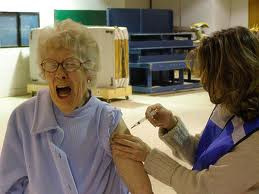 The flu shot is free – and it doesn’t hurt THAT much. The Chief Medical Officer of Health for Ontario, Dr. Arlene King, is reminding Ontarians to protect themselves from influenza by getting the flu shot. She stresses the importance of getting immunized – particularly with an increased proportion of laboratory confirmed cases of the 2009 H1N1 flu virus in the province and across the country this year.
This strain of influenza affects people of all ages, but children under five and those age 20 to 64 years old appear to be most susceptible. To date, children under five appear to be most at risk of hospitalization. Deaths have been reported in adults and the elderly.
The flu vaccine is safe and the best way to keep you and the people around you healthy during the flu season.
The Region announced today that that the last two regularly scheduled influenza (flu) immunization clinics will be held on Wednesday, January 8 and Wednesday January 15, both from 4 p.m. to 8 p.m. in the auditorium at the Halton Regional Centre in Oakville.
The H1N1 influenza virus is currently circulating in Halton and this strain of virus is included in this season’s vaccine. It is not too late to get your flu shot to protect yourself and to prevent spreading the virus. Residents can still get their flu immunization from many pharmacies, clinics and doctors’ offices.
The free flu vaccine is available at doctors’ offices and is also available for those five and older through specially trained pharmacists at close to 2,000 pharmacies across Ontario – three times as many pharmacies as last year. Rexall pharmacies in Burlington offer the service as well as others.

 December 12, 2013 December 12, 2013
By Staff
BURLINGTON, ON. All that cold weather we have been experiencing will begin to pay off for us Friday afternoon.
The pond at Spencer Smith Park will open at 4:00 pm where the skating is free to everyone.
 Pond opens to the public Friday afternoon. The pond is open daily from 10 a.m. to 10 p.m. with patrollers working on Saturday and Sunday from 10 a.m. to 10 p.m. and on weekdays from 4 p.m. to 10 p.m.
The holiday schedule includes:
Christmas Eve, December 24th : 10 a.m. to 8 p.m.
CLOSED Christmas day
New Year’s Eve December 31st 10 a.m. to 10 p.m.
New Year’s Day January 1st 10 a.m. to 10 p.m.
Please remember that you must wear skates to be on the ice and children 6 years of age and under must wear a helmet.
You can call the Pond hot line for ice conditions – 905-634-7263 or visit the web site for temporary closure information, updates on pond conditions.

 December 8, 2013 December 8, 2013
By Pepper Parr
BURLINGTON, ON. It has been a good year for the Joseph Brant Hospital. Not as good a year for old Jo Brant himself – the Pooh-Bahs at the hospital decided to drop the word Memorial from the official name and came up with a spiffy new corporate logo as well. Times change.
 The hospital did a topping off ceremony for the Halton McMaster Family Health Centre (there’s a name screaming for something shorter) and announced how well the fund raising program has been doing. Incredibly well is the best way to describe the $16.5 million that has been raised. The target is $60 million the hospital foundation has been tasked to find. The hospital did a topping off ceremony for the Halton McMaster Family Health Centre (there’s a name screaming for something shorter) and announced how well the fund raising program has been doing. Incredibly well is the best way to describe the $16.5 million that has been raised. The target is $60 million the hospital foundation has been tasked to find.
In the world of fund raising “seven digits” is what you go looking for – it’s sort of like the single malt of the fund raising world – and these are not easily come by. Romancing seven digits calls for a skill set few can bring to the table. Anissa Hilborn, president of Burlington’s Joseph Brant Hospital Foundation has done a remarkable job. The rate of donations is “unheard of”, which is a testament to both the Foundation and the generosity of the community.
Today there is $16.5 million in campaign commitments – achieved in less than two years’ time.
The Molinaro family brought $1 million to the table, the Hogarth clan followed with an additional million. The Sante/Peller family added $500,000. Before any of this happened the Boards and Senior leadership at the hospital put their names down for $23.5 million.
Burlington’s four Rotary Clubs put themselves down for $1 million. Before anyone got out a cheque book however the hospital auxiliary committed to $3.5 million
Ambassador Giving Societies and Circles were launched in January of this year. The Crystal Ball Gala will be held on September 14 of 2014. It is all rolling out rather well.
The public phase of the campaign will be launched when $45 million of the $60 million goal has been reached. All of this is no small achievement and is a significant credit to the Campaign Cabinet made up of 20 community and business leaders.
 The Family Medical Centre will be in the structure under construction on the left – with the parking garage on the right. There will be a passageway from the parking garage right into the hospital. No word yet on the parking prices. With the fund raising well in hand – hospital CEO Eric J. Vandewall talked about the progress and the construction schedule. First piece of good news was that the provincial government put a little more money on the table.
Next: the hospital has settled on three consortiums who are going to bid on the construction of the building which will be an additional story higher than originally planned: seven floors instead of the six in the original thinking – however the building is going to look a lot bigger than just seven floors of space for people to get better in.
 They have a timeline in place – now to keep everyone fully informed. There will be an additional two floors above the actual hospital which will house all the electrical and mechanical equipment making the building look like a nine story structure which will be a couple of hundred yards from the edge of the lake and will dominate the western side of the city.
In the very near future Burlington’s sky line is going to experience a radical change with the Bridgewater condominium/hotel in the middle of town soaring to a height of 22 storeys and the hospital reaching up nine storeys.
 The hospital site will take on a campus like setting with the buildings oriented to the lake. The project is being headed up by Infrastructure Ontario – they work hand in glove with the hospital scoping out just what is needed, where value engineering can be used to get the best for the dollars being spent. It is at this level that Vandewall shines. The work he did in Mississauga prepared him for the Joseph Brant challenge.
What was originally going to be the renovation of an aging hospital that was well past its best before date, and carrying a nasty reputation as well, has morphed into basically a rebuild with a brand new facility set off to the western side.
Vandewall does remarkable work – he is unfortunately not as well served on the communications side. The hospital is filled with great good news stories that don’t get told. Their media relations are terrible.
 Entrance to the hospital will be from either the parking garage which will be on the west side of the hospital connected by a passageway or from the street level entrance that will front onto Lakeshore Road. The new tower will have 172 new beds; there will be a new Emergency department; a new intensive care unit, a renovated Special Care Nursery.
While the focus is on the hospital, contractors have been working away at the Halton McMaster Family Health Care Centre that will attract ten new family practice doctors. Attached to the Health Care Centre will be a three level parking garage with capacity to have an additional two floors of parking added.
The hospital site will take on the look and feel of a campus – it will be a much different site than the collection of services out there now. All the construction work gets done while the care givers and the surgeons continue to go about their daily work.
Background on hospital development:
Paying the CEO
Parking garage – how it got paid for.
Getting the Family Medical Centre

 November 26, 2013 November 26, 2013
By Pepper Parr
BURLINGTON, ON. The way Mayor Goldring saw it – Burlington is basically getting a new hospital. The provincial government announced today that funding increases will amount to “hundreds of millions” more for the rebuild of the hospital
Health Minister Deb Matthews was in Burlington to announce major changes to Joseph Brant Hospital’s expansion project, but wouldn’t talk money or exactly how much the province will contribute to help fund those changes. What was a $312 million project is being re-scoped – up.
While the real number of beds being added along with the number of operating rooms wasn’t clear Mayor Goldring reported that beds were going to be 172 up from the previously planned 92 and nine new operating rooms.
 Architects rendering of what the re-build of the Joseph Brant Hospital will look like. The angle is looking east into the city. The structure has had an additional floor added. $60 million of that $312 is coming directly out of the taxpayers’ pockets – it shows up on your tax bill with another $60 million being raised by the hospital foundation that has done rather well in the recent past.
Matthews and hospital officials said they can’t be specific about how much more money the province is giving the hospital expansion because it would tip the hands of the construction companies bidding for the work. That’s a bit of a stretch – the major contractors are a lot closer to the people who determine those numbers than the taxpayers whose pockets the money comes out of
The hospital announced the plan’s major upgrades mean adding another storey to what was originally a six-storey newly constructed tower, adding beds although it was unclear how many are additional rather than revamped or what the hospital called “renovated” beds. The changes will also mean the emergency department and three floors of current surgical beds will move to the tower now.
Matthews and hospital officials said the changes essentially allow parts of the project that were to consist of renovations to now be built brand new, such as in the case of the emergency department.
 An architects rendering of the new entrance to the Joseph Brant Hospital which will now face the lake. The entrance will be off LAkeshore Road with the new parking lot just to the west of the hospital. “As planning got underway, the hospital realized it would get better value to build new rather than renovate,” Matthews said. The new emergency department for example, will be state of the art in meeting the needs of the community”, she said.
“The emergency department is the public face of the hospital…It’s better value (to build new) and it will better meet the needs of the community,” she added.
Jo Brant CEO Eric Vandewal said the main benefit of a new emergency department will be reduced waiting times — the same benefit mentioned when emergency renovations were talked of as part of this major expansion, and again in 2001 during a $12.6 million expansion and enhancement of the emergency department and cancer clinic. Clearly saying that wait times will be reduced is what the public wants to hear.
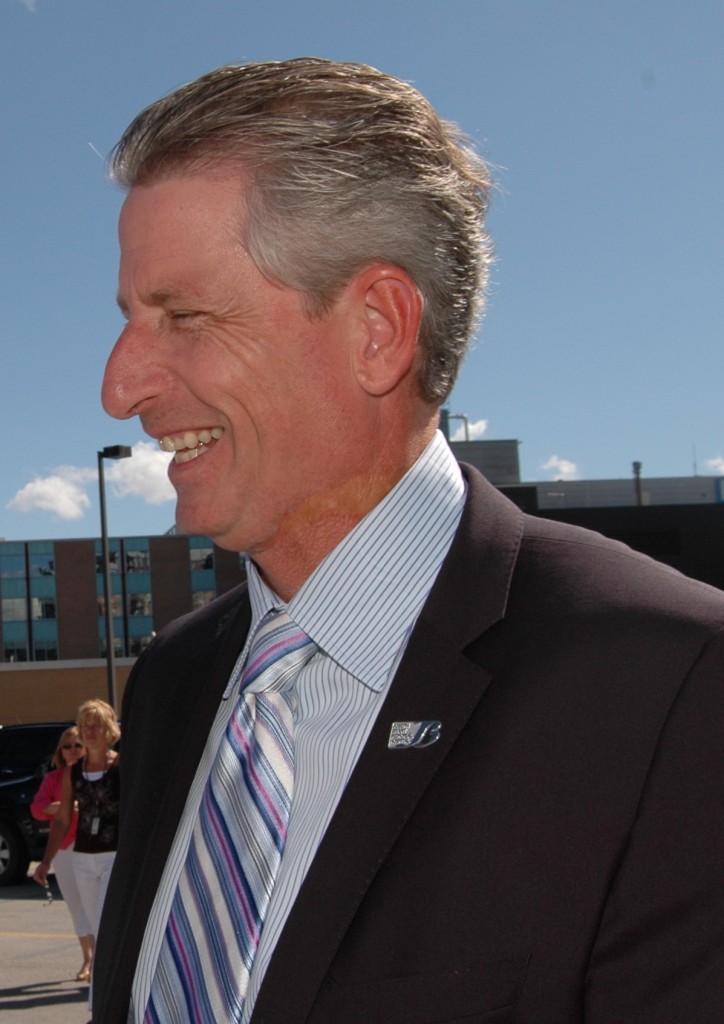 Joseph Brant Hospital CEO Eric Vandewal Vandewal, who has an earned reputation as a hospital builder, did very good work in Mississauga before he came to Burlington. One could almost imagine the arguments he took to Queen’s Park telling them he could deliver much better value if he was to build new rather than upgrade an older facility.
The hospital will hold a “topping off” event very early in December to mark the completion of the first phase of the Halton McMaster Family Medicine Centre structure, which is to have medical facilities on the ground floor with three parking levels above. The structure is being built to allow for an additional level of parking at a later date.
|

 November 1, 2013 November 1, 2013
By Pepper Parr
BURLINGTON, ON. Doctors will tell you that children under five are at the highest risk for serious illness from influenza. With the weather cooling off and a new flu season fast approaching, Ontario’s Chief Medical Officer of Health Dr. Arlene King is asking parents to make sure their children get the flu shot.
The highest numbers of flu cases are in the one to four-year old age group. Dr. King stresses that the sooner kids get the flu shot the better since it takes about two weeks to become fully effective.
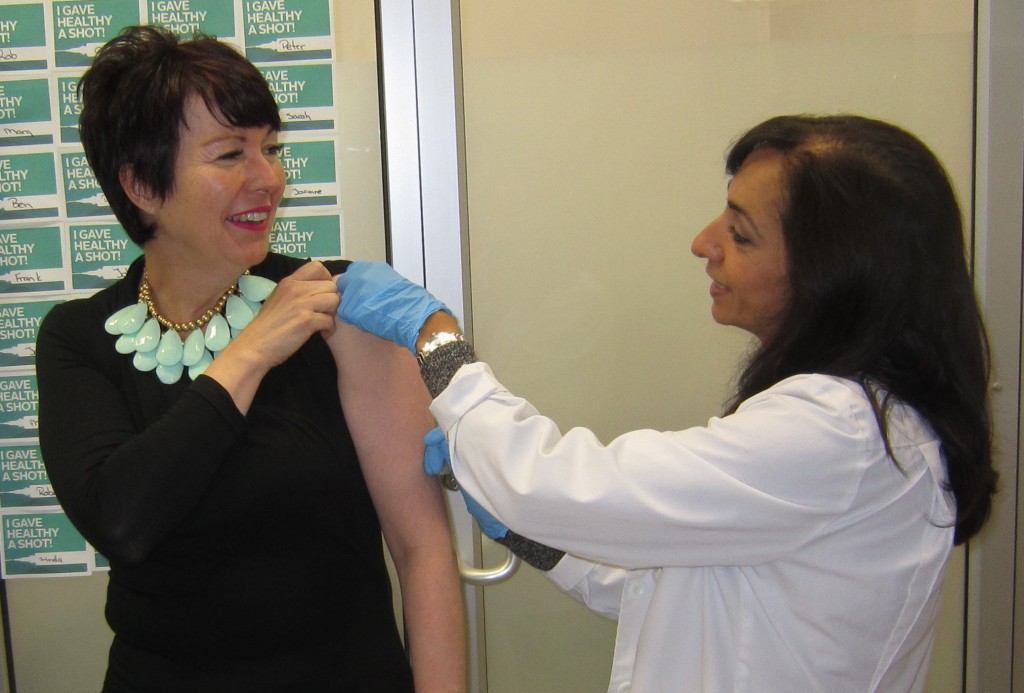 Burlington MPP Jane McKenna gets her annual flu shot from Anita Sahu at the Rexall Pharmacy on Guelph Line. Children between the ages of six months and four years old can get their flu shot at doctors’ offices and at public health or community flu immunization clinics.
Burlington MPP Jane McKenna gets her annual flu shot from Anita Sahu at the Rexall Pharmacy on Guelph Line.
For parents, caregivers and children aged five and up, thousands of Ontario pharmacists will also be offering free flu shots as part of the Ontario government’s Universal Influenza Immunization Program, designed to make it more convenient for people to protect themselves and others from the spread of influenza.
This year, pharmacists at almost 2,000 drug stores across Ontario will be fully trained and ready to deliver free flu shots – roughly triple the number of pharmacy locations as last year.
Jane McKenna, MPP for Burlington, and one of the healthiest people we know, got herself over to the Rexall pharmacy on Guelph Line where pharmacists Anita Sahu did the deed and ensured that the MPP will be able to continue standing in the provincial Legislature barking away at what the government isn’t doing to make the province economically healthy.
McKenna, a first term parliamentarian, quickly became an ideologue and bought into every word the provincial Tories wrote in the Change Book. .
How Blue is Jane McKenna? As she was filling in the forms to get her flue shot she asked aloud – “What’s the date today? November 1st replied her daughter Taylor who was with her. “Oh – today is Tim Hudak’s birthday”replied McKenna.
McKenna is now the Progressive Conservative critic for Economic Development, Trade & Employment; one of the weightier portfolios that usually has an experienced parliamentarian with some depth in business. McKenna plans on holding a Round Table on the Economy sometime in the New Year.
The flu shot is now available in Ontario and Rexall is one of the pharmacies that has made it easy and convenient for Ontarians to receive the vaccine by offering it at any store, at any time, any day – no appointment necessary.
Last year was the first year pharmacists were able to administer immunizations in Ontario and, and according to Rexall, 80% of flu shots given by pharmacists were at a Rexall.
According to the Ministry of Health and Long-Term Care, the flu and its complications result in up to 1,000 hospitalizations and 1,600 deaths in Ontario each year.

 October 18, 2013 October 18, 2013
By Dr. Jeremy Hayden.
BURLINGTON, ON In light of the looming cold and flu season, I am interjecting with a brief mention of a promising, true and tested approach to improve one’s health (and I’m talking about thousands of years here folks, not a time frame to take lightly). Granted traveling south for the winter may be the most attractive option, running from those pesky winter viruses and bugs won’t ultimately fix what may already be broken. We all should know that a whole person approach to a healthier more robust system should be first and foremost, yet it’s often quite evident that what we know is best for one self, due to lack of time, motivation, commitment and effort, is, for some, sometimes a lot easier said than done…
Reference to fighting a cold or flu is often a primary focus for many. The immune compromising winter season is one which too often places unnecessary and undue stress on our bodies. One may argue that getting sick or catching colds build the immune system and is beneficial, which to an extent may be true. However wouldn’t you prefer to reap the same benefits by doing so without ever needing to get sick? Within the Naturopathic Medical (and Natural living) realm, the realization of this can be achieved, and often with simple ease; strengthening our innate and adaptive immunity whist keeping happy and healthy throu gh it all. Why position ourselves to have to fight these bugs, when we can utilize and take advantage of their unwanted effects to better our overall health? gh it all. Why position ourselves to have to fight these bugs, when we can utilize and take advantage of their unwanted effects to better our overall health?
Herbal medicine is a practice that will help achieve this common goal
Herbalism is utilized to incorporate the vaccination stimulating effects of cold and flu viruses in order to ramp the immune system while simultaneously building immunity to those pesky cold and flu season bugs. Think of it similar (relative perspective here) to getting a vaccination shot; the bug or virus enters the body, provides a stimulus to our immune system, enough to create a resistance to its current and future presence, yet without the effects of making us sick. Enter the herbal medicine perspective; Cold and flu bugs are inhaled and enter the body day-to-day from those around us who may be infected by a cold or are sick. Specific herbs taken prophylactically allow the body’s immune defenses to become stimulated and build immunity to various cold and flu strains, yet due to the stimulation and balancing effects of concentrated herbals, the immune system is strong enough not to allow these ‘bugs’ to take over and make us sick.
 Herbal medicines are not injected – they are swallowed. Basic facts about herbal medicine for a better immune
Most immune herbals are safe when used as outlined on the bottle.
Little to no contraindications exist when using these herbs (contact a licensed natural health care practitioner if and when in doubt or if complicated health issues may exist)
· Herbal tinctures (liquid herbal form) are often the best option for many people as they concentrate the active constituents of a herb and allow for better therapeutic effect.
· Immune herbals often have long-lasting therapeutic immune effect.
· Liquid herbals are considered food type medicine; they are in whole form, grow naturally, and are unadulterated, but concentrated naturally, so our bodies recognize and utilize them best
· Herbals work well as individual (single herb) extracts, however will work to a greater synergistic effect when combined together
· Look for Canadian companies that represent true certified organic, pure herbal tinctures (all are not created equal!)
Top immune prophylactic herbals are:
Astragalus root, Siberian ginseng,codonopsis, schisandra, reishi and licorice root.
Look for herbal liquid tinctures that contain some or all of the above immune herbals. Effective herbals exist for acute immune compromise as well (existing cold), so don’t hesitate to use an Andrographis, Baptisia, Echinacea, Thuja herbal combination to ‘beat the current bug’ (discontinue other immune herbals until the acute virus has been eradicated). A minimum of three-month prophylactic treatment is always best, however supporting your immune system at any point will help your body remain healthy, build immunity and prevent that nasty cold or flu.
Finding a supplier that is reliable is not always easy in a market that is not that tightly regulated. People in the naturopathic field are always very comfortable recommending products from St Francis Herb Farm
What is a naturopathic doctor? Where an MD focuses more time on pharmaceutical medicine, NDs also study pharmacology and its drugs, however extensive training in natural medicine (such as botanical, Oriental, nutritional, physical, and homeopathic medicine as well as lifestyle, counseling and herb-drug interactions) is adjunctively studied as well. In Ontario, a naturopathic doctors is considered a primary care physicians. NDs cannot prescribe pharmaceutical medications in Ontario as MDs are able to, and are only covered under extended health plans and not OHIP billing, however they are able to employ conventional laboratory testing and diagnostic imaging as necessary.
 Jeremy Hayden, Doctor of Naturopathic Medicine (ND). ND is a professional medical designation earned following an undergraduate pre-medical degree and four years of post-graduate medical training at a fully accredited (CNME) naturopathic medical college. All licensed Naturopathic Doctors practicing in Ontario have been fully regulated under the Drugless Practitioners Act. Jeremy Hayden, Doctor of Naturopathic Medicine (ND). ND is a professional medical designation earned following an undergraduate pre-medical degree and four years of post-graduate medical training at a fully accredited (CNME) naturopathic medical college. All licensed Naturopathic Doctors practicing in Ontario have been fully regulated under the Drugless Practitioners Act.

 October 8, 2013 October 8, 2013
By Dr. Jeremy Hayman
BURLINGTON, ON. On the heels of my last submission on food as medicine and its real impact on all aspects of health, I now find it necessary to give readers a glimpse into food as choice and exactly what it is we are feeding ourselves, our children, and our loved ones each day. I’m not lecturing those of you who chose to eat a certain way, or those who consume certain foods by what I refer to as “dietary default”. My intention rather is to put what we know about food, on the table, and remind us all about the importance, impact and value of not only what we put into our bodies, but what we ultimately leave out.
 The term “dietary default” refers to a multitude of references when it comes to our association and relationship with food. Within the context of this discussion, I’m referring to those who consume foods without truly thinking about what or why they consume the foods they do. And out of fairness, it also stoutly refers to foods the average population so simply shy’s away from and leaves out. To delve into this even further, it refers to those who almost automatically follow a routine eating regimen, eat the same foods week to week, and most importantly, rarely, if ever, truly think about the impact of what they eat, or how it will ultimately consume them in the short and long haul with respect to health. The term “dietary default” refers to a multitude of references when it comes to our association and relationship with food. Within the context of this discussion, I’m referring to those who consume foods without truly thinking about what or why they consume the foods they do. And out of fairness, it also stoutly refers to foods the average population so simply shy’s away from and leaves out. To delve into this even further, it refers to those who almost automatically follow a routine eating regimen, eat the same foods week to week, and most importantly, rarely, if ever, truly think about the impact of what they eat, or how it will ultimately consume them in the short and long haul with respect to health.
 Advertising plays a large role in what we decide to east. It has become glaringly obvious that societal impact grossly influences the choices and food we ultimately serve on our plates. Yet, with the ever so abundant “way of life” when it comes to our choices (or lack of) with respect to diet and food, the unmistakable contrary reflection also positions itself just as clear and states: “those who do choose what and how they wish to live in harmony with food, do so with absolute clarity and passion, and make it a way of life in order to maintain and pursue continued improvement toward better health”.
We know food affects health. We are also becoming more and more aware of which foods are most important, which are not, and which of the same foods contend as healthier choices over others. Some of us default to the convenient way and eat within the “fast food peril” of life. While others, albeit a smaller, yet ever-growing movement of people, place food and its nutritional value as one of the most prominent elements in life. These people live “against the grain” in terms of what society dictates we should eat. These are the people who won’t simply surrender to the “conveniences” of today’s living, and make it a true effort to do what is necessary in order to preserve the short and long term health of themselves as well of those they love. What do I mean by this? Well let’s serve it up in the most simple, succinct, digestible way…
 With the overwhelming amount of mass media making use of its privilege to feed us its messages on what/what not to eat, how to eat, when to eat, why to eat, where to eat etc., it’s no wonder there’s an endless endeavor to try and figure it all out. Let alone pressures from others on our way of eating, we end up living in a whirlwind of relentless persuasions about what is best for ourselves and others. I’m here, as a Naturopathic Doctor, within a profession strictly to support and better the health of those that can be reached, and without alternative motives, to do what I can to lay it out, in plain English, what it is we need to begin allowing our lives to let in, in the most natural and least invasive way. With the overwhelming amount of mass media making use of its privilege to feed us its messages on what/what not to eat, how to eat, when to eat, why to eat, where to eat etc., it’s no wonder there’s an endless endeavor to try and figure it all out. Let alone pressures from others on our way of eating, we end up living in a whirlwind of relentless persuasions about what is best for ourselves and others. I’m here, as a Naturopathic Doctor, within a profession strictly to support and better the health of those that can be reached, and without alternative motives, to do what I can to lay it out, in plain English, what it is we need to begin allowing our lives to let in, in the most natural and least invasive way.
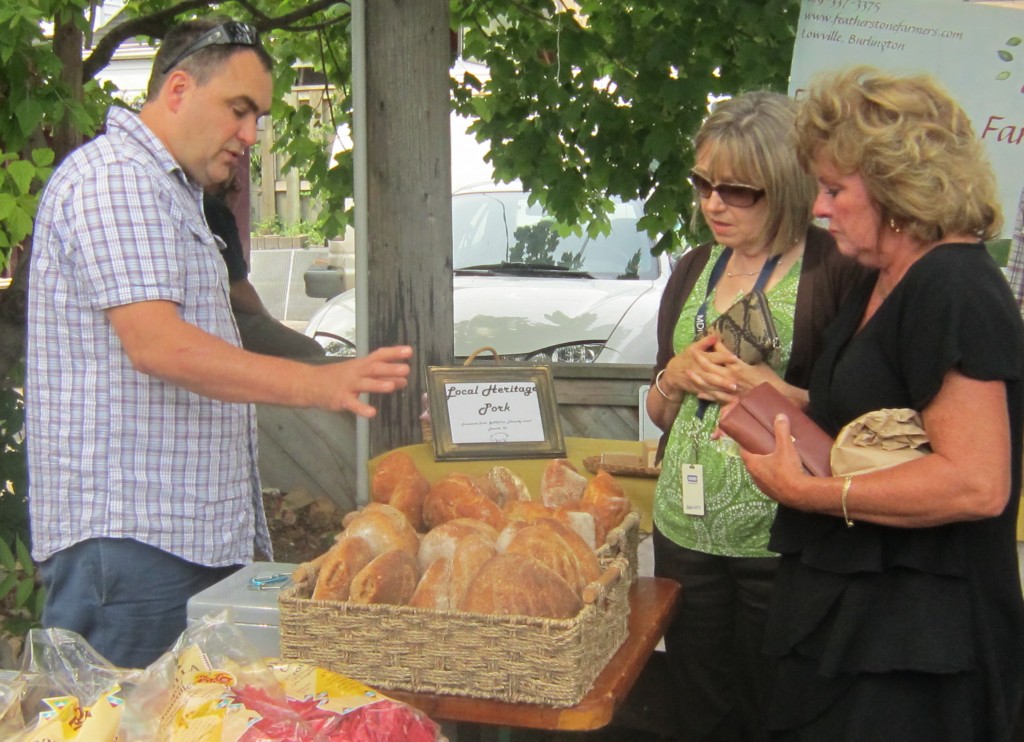 There is almost no limit to the food that can be bought at a Farmers Market. We’re all aware that balance in life is a precious gift, and one we, at some level, strive for (some more than others) each day. However, today’s message is that food, and food alone, can and will impact that balance to a more positioned and eloquent equilibrium. There’s no question many of us know what to eat and what not to eat, yet most of us either don’t know how or are lost in terms of where to start. Well, the truth is that it’s not always easy, there’s not one simple answer, and we’re all moving at various paces and levels within the food-life conundrum, yet by recognizing a few simple and effective “food-life rules”, you can and will feel better, stress less, live healthier, and learn that food truly is one of our most precious resources. We all need to treat food as food, and as a living entity, not as a product, a skew, or packaged commodity. So here’s where we’re at, a simple, realistic checklist of where to start, and a reinforcement to those that are already there:
· Follow the Dirty Dozen Plus & Clean 15 when it comes to buying conventional and organic.
· Become aware of GMO’s (Genetically Modified Organisms) and which foods contain them (use 1 less GMO per shopping trip per month – a GMO pepper is proving much riskier than a non-GMO organic pepper)
· Add one new vegetable per month (to start), preferably organic, into your meal routine
· Eat a vegetable (you know, that stuff that grows from the ground?) at most meals
· Try an outing to a local farmers market. Local food is great, however local pesticide, herbicide and anti biotic free is even better. You and your children will enjoy the excursion.
· Eat less meat. And spend the money on more healthy, clean meats
· Make more of an effort to drop in at your local health food store. They’re local small businesses. Do your duty and provide your support
· Realize that fast food and eating out essentially supports only your busy, unplanned schedule, it adds no value to your life. It will catch up with you, unless of course it already has
· Drink organic herbal tea. It curbs cravings and adds endless benefit to your health
· Begin thinking of food in terms of its nutritional impact. To eat for the simple value of being hungry or for calories is like living in terms of simply “eating to survive, not thrive”
· If you are not happy with your current weight, either accept you will remain like this and continue to allow your health to regress, or stop making excuses and commit to the effort of making a change
· Figure out a way to realize that spending more on healthy food now costs you much less than fighting for your health in the years to come
· Combine lean protein, vegetables and healthy fat within each meal
· Plan for goodness sake. We’re all busy, yet some of us still make time for our health. It won’t take care of itself
· Seek out support if you don’t know where to begin. You’re spending enough on unhealthy choices already, it’s time to commit to putting that spending money toward better value
· Naturopathic Medicine and other natural health professionals are here to help. Our ultimate goal is to make our planet and those within it healthier.
· Drink clean water. 2L minimum per day to start
· Make yourself proud. Do something for your health that in the way of better food choices that most wouldn’t have the nerve to try. Trust me, everyone will admire you in the end, yourself included.
[

 October 1, 2013 October 1, 2013
By Pepper Parr
BURLINGTON, ON. It wasn’t hard to figure out what the major message was behind the 2013 version of Burlington’s Vital Signs report is: there are many in the community who just don’t have enough – and it isn’t just the “poor” people that are going without.
The Burlington Community Foundation, around since 1999, released, along with 26 other communities across Canada, a report that touched all the usual bases and added in a significant push on the pressing needs for better access to mental health services.
The Vital Signs report is data driven and uses graphics very effectively to make the point. The cartoon cover page is Burlington: there’s the gazebo (I met my wife for the first time there) there’s Pepperwoods, there is Benny’s and the gas station. The drawings are all in colour and attractive in their own way. Cute – it isn’t until you get to the second page that the point is made. Well – compare the two versions and you know in an instant what the report wants to talk about.
The report is the second published by the Community Foundation. The 2013 report covers eleven key areas of focus, including physical and mental wellness, poverty, youth, and seniors.
“This year’s report again emphasizes that Burlington is a city of contrasts. We are a prosperous community, with higher than average levels of income and education, with remarkable environmental features such as our escarpment and waterfront. Yet, there are people struggling in our community, in ways that are often unseen, as we drive and walk through our neighbourhoods”, said Burlington Community Foundation (BCF) President and CEO, Colleen Mulholland.
Who are the people that collect all the data and tie the different strands that are woven into the tapestry that is our city?
Established in 1999 as a centre for philanthropy, Burlington Community Foundation is a local knowledge broker and one of the most reliable partners in the non-profit sector. They collaborate with donors to build endowments, give grants and connect leadership. Responsive to their donors, the grant making experts help people give, build legacies, address vital community needs and support areas of personal interest. The Foundation helps people, agencies and corporations improve the city’s vitality.
 Cover: 2013 Vital Signs report commissioned by the Burlington Community Foundation.  Take away the good stuff, the nice stuff and the picture is that of a different Burlington – not one we all get to see. The report argues that “connections are critical to community vitality” but how do you do that? You’ve heard it before and with a municipal election just over a year away you will hear it again from every one of the rascals running for office: – Burlington is ranked as the top mid-sized city in which to live in Canada.
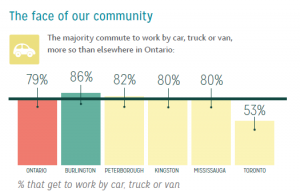 We drive – everywhere, in part because local transit has yet to develop to the point where it serves the community as well as it is going to have to. Biggest reason – we like our cars. And we drive our cars – to everything. 79% of Ontarian’s commute to work by car, truck or van. That number is 86% for Burlington where we have an excellent, frequent train service that has three stops in the city with plenty of parking – free.
We vote – in the last federal election 66.5 of us voted while the Ontario average was 61.5%. Didn’t do much for us in terms of the quality of our elected members though did it?
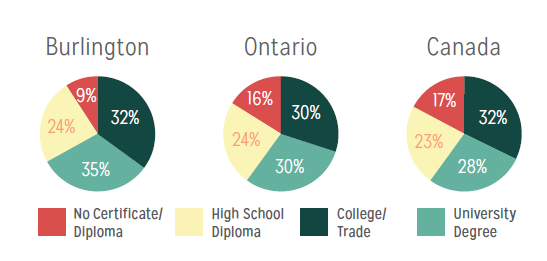 We have one of the best educated populations in the province. We are a well-educated community – check out the charts.
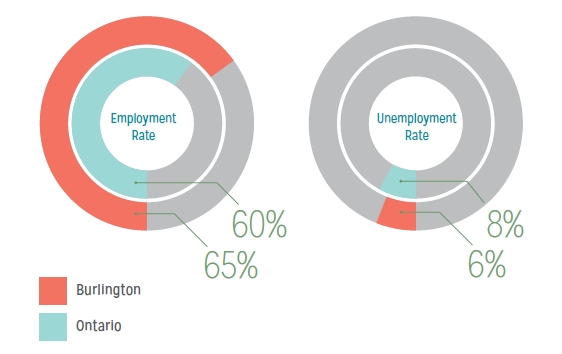 Burlington is doing better at both the number of people with jobs and the number that are unemployed. But there are other indicators that reveal serious problems. Our people are employed – they need to be – our housing is amongst the most expensive in the province and rental accommodation is not easy to come by.
Median household income levels are 24% higher in Burlington than the provincial average but according to Statistics Canada, almost 1 in 10 youth under 18 lived in a low-income household.
In 2012, 36% of all items circulated by Burlington public libraries were in the child or youth category. Attendance at children and youth programs at Burlington libraries was 35,195.
Overall, the age profile of Burlington is getting older and more so than the Ontario average – in 2011, there were 29,720 seniors 65 years of age or older living in Burlington, comprising 16.9% of the population vs. 14.6% in Ontario.
Young people in Burlington are preforming well in school compared to the Ontario average but there are some opportunities for improving the lives and outcomes for our youth, starting as early as kindergarten. Some issues we need to tackle as a community are obesity, bullying and mental health.
Burlington residents are better educated than the population of Ontario and Canada. 67% of Burlington adults 25 years of age and over have completed some form of post-secondary education, compared with 60% of the population of Ontario.
Among Burlingtonians 25–64 years of age, 95% have completed high school – this is a big positive change in a 10 year period: in 2001, 79% had completed high school.
In 2011, there were 143,510 people 15 years of age or older in Burlington. Within this age range, 93,030 people were employed and 5,755 were unemployed for a total labour force of 98,785.
Burlington has stronger employment statistics than Ontario as a whole. The employment rate among people 15–64 years of age was 65%, compared to 60% for Ontario. Burlington’s unemployment rate was 6%, compared to 8% for Ontario.
For the past 10 years, the rate of unemployment in Burlington has been consistently lower than elsewhere in Ontario and in other communities across Canada.
Here are some quick facts about jobs and businesses in Burlington, according to the Halton Region 2012 Employment Survey, released in June 2013:
The City of Burlington has 4,638 businesses providing 74,216 full and part-time jobs.
While Burlington accounts for 35% of the 15–64 year olds living in Halton Region, jobs in Burlington accounted for nearly 40% of Halton’s total employment.
Approximately 80% of jobs were in the service-based sector – the leading ones being the retail trade, professional, scientific and technical services, and health care and social assistance.
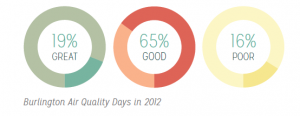 Can we blame the air quality problems on Hamilton? Air quality good – but could be better
Burlington has good air quality, compared to downtown Hamilton. Hamilton has more poor to moderate air quality days (22%) than does Burlington (16%).
However, Burlington’s location in southern Ontario – in Canada’s manufacturing heartland and downwind from the industrial centre of the U.S. – increases the number of poor to moderate air quality days relative to more northern parts of Ontario and cities in other parts of Canada. For example, in each of Sudbury and Ottawa only 8% of the days in 2012 had poor to moderate air quality compared to 16% in Burlington.
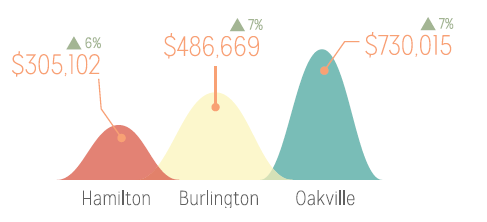 Price increases are great if you own property – tough market to get into for first time buyers. The average price of a home in Burlington in the first half of 2013 was $486,669 – up 7% from 2012.
Similar increases were seen in the neighbouring cities of Hamilton (+6%) and Oakville (+7%), with Burlington housing costs continuing to be intermediate between these two cities
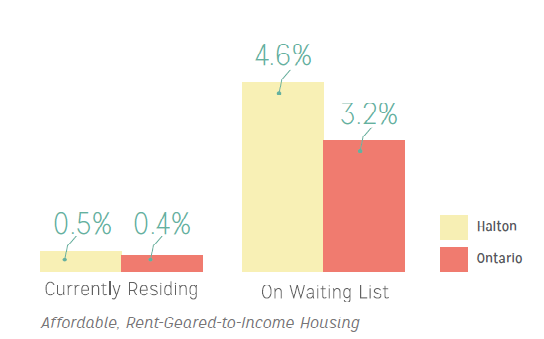 Burlington’s rental market is tight – far too tight. The city thought it had a hope recently with close to 100 affordable units coming on line – but that one got away on us. People looking to rent – particularly those with more modest incomes – can find it difficult to find affordable rental housing in Burlington. In fall 2012, Burlington’s rental vacancy rate was 1.3%. For reference, a vacancy rate of 3% is considered necessary for adequate competition and supply. By comparison, Hamilton’s vacancy rate was 4.2%, and in Ontario as a whole it was 2.5%.
In 2011, Halton had a higher percentage of households (4.6%) on waiting lists for affordable, rent geared-to-income housing than was the case for Ontario as whole (3.2%). Further, the demand for this housing greatly exceeds the supply, as only 0.5% of Halton households were living in affordable, rent- geared-to-income housing in 2011.
In Halton, between 2010 and 2011 there was a 47% increase in households waiting for rent-geared-to-income housing. Families with children are the hardest hit.
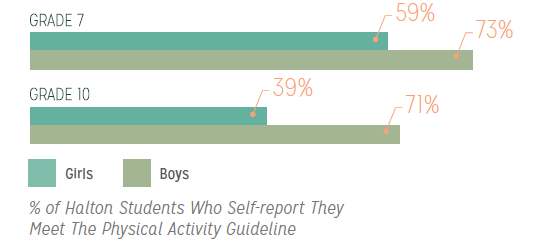 The kids think they are getting the exercise they need – caution, this is “self-reported” data. Residents of Halton are more likely to rate their overall health as “very good” or “excellent” (72%) compared with Ontario residents as a whole (61%). Moreover, positive health ratings increased from 2011 (66%) to 2012 (72%).
Over 75,000 Burlington residents 18 years of age and older are overweight or obese based on their self-reported height and weight. That’s just over half of the adult population who have an increased risk of certain health problems, including Type 2 diabetes, hypertension, coronary heart disease, gallbladder disease, obstructive sleep apnea, and certain cancers.
Mental health is now at least being talked about – it isn’t something we hide the way we used to – that was an improvement for the better. Now we have to address the problem and it is not going to be cheap.
 The Canadian Institute for Health Information tracks the performance of over 600 health care facilities across Canada on a variety of indicators of effectiveness of treatment, patient safety, appropriateness of treatment, and accessibility. JBH is either at or better than the Canadian average on all of the indicators. The Canadian Institute for Health Information tracks the performance of over 600 health care facilities across Canada on a variety of indicators of effectiveness of treatment, patient safety, appropriateness of treatment, and accessibility. JBH is either at or better than the Canadian average on all of the indicators.
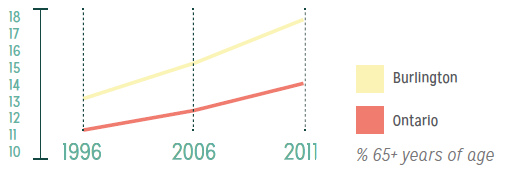 Seniors need different services. The city currently has one Seniors’ Centre and at least five high schools. Will we need additional Seniors’ Centers that can be converted to high schools 30 years down the road? There are some significant problems to need solutions and we don’t have a lot of time to find the answers. Canada’s age profile is getting older, and this trend will continue for several decades into the future. For example, the proportion of people 65+ years of age in Ontario is expected to grow from 14.6% of the population in 2011 to over 23% by the year 2036.
Burlington’s age profile has historically been older than that of Ontario as a whole, and the difference has been increasing over time. As of 2011, 16.9% of Burlington’s population was 65 years of age or older, compared to 14.6% of Ontario’s population.
 Burlington has more of the Region’s senior population – do we have well thought out plans to meet their needs? Based on Statistics Canada measures of low-income from the 2006 census, 5.6% of Burlington seniors have low-income after tax. However, the prevalence of low-income is particularly acute among female seniors in Burlington: this prevalence is higher than the Ontario average, and higher than other Halton region communities.
In 2006, about 1,800 senior households in Burlington spent 30% or more of their total household income before tax on mortgages, electricity, heat and municipal services. Of these, almost 500 spent 50% or more of their income on housing, which leaves very little money for food, medications, or other necessities.
In the Age-Friendly Communities Forum: A Seniors’ Perspective – an initiative of the Elder Services Advisory Council In Halton Region – the Burlington participants identified a need for affordable housing as one of the top 3 issues for seniors in Burlington, and noted that “some people are moving out of the community as they cannot afford to live here.”
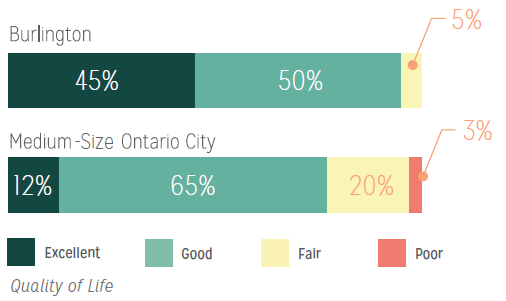 We love the place. Burlington residents tend to see the quality of life in the city as improving: 27% said the quality of life in Burlington has improved over the past two years, compared to only 11% who said it has declined.
Survey respondents were asked which factors had the greatest impact on quality of life in their city. What set Burlington residents apart particularly was the importance of a low crime rate, and a strong sense of community.
In a survey of Burlington residents, 76% said culture is “essential” or “highly important” in their daily lives. There are many types of cultural experiences. For Burlington residents, the top 6 are festivals (86%), museum & local history (81%), art galleries (78%), going to the theatre (75%), public art (69%) and family heritage & traditions (69%).
Benefits to Burlington from community cultural organizations include:
624,000+ visits to local festivals, events, productions and exhibitions
89,000+ hours of cultural programming offered to all ages
Burlington residents spend 37% of their cultural time in Burlington, and the remaining time in other cities such as Toronto and Hamilton.
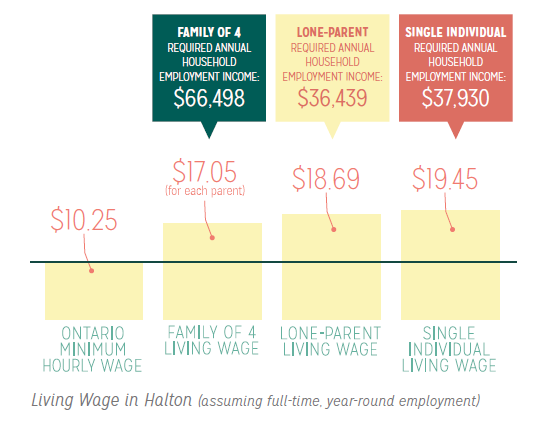 These numbers are the reality for many. A person cannot live on the minimum wage – it has to be close to doubled – and that’s not something a municipality can do. Ontario has a legally mandated minimum wage of $10.25 an hour. However, a person working full-time at the minimum wage rate will be living in poverty, as they will earn less than Statistics Canada’s Low Income Cut-off.
The concept of a “living wage” is motivated by the following question: What does a family working full-time (37.5 hours a week, year-round) need to earn in order to pay for the necessities of life, to enjoy a decent quality of life, and to be able to participate fully in the economic, political, social and cultural life of the community?
The answer to this question depends on family composition and on where you live. Community Development Halton has tackled this question for the Halton Region, including Burlington.
What is included in a living wage, and what is excluded? “A living wage isn’t extravagant. It doesn’t allow families to save for retirement, to save for their children’s education or to service their debt. But it does reflect the cost of affording the basics of life – something the minimum wage doesn’t do,” states the Canadian Centre for Policy Alternatives.
Community Development Halton considered three types of Halton households: a family of 4 (two parents, two children – a boy age 10, and a girl age 14), a single-parent family (mother age 30 and a boy age 3), and a single person (male age 32). In each household, each adult is working full- time, year-round. The calculation of living wage reflects the typical costs in Halton, as well as taxes and benefits.
 The number of youth have grown since 2006 but the senior population has grown more. The number of youth in Burlington has increased since 2006, but at a slower rate than older age groups. As a result, the overall age profile of Burlington is getting older.
Burlington is an affluent community, but not everyone is well off. In the 2006 census, 7% of all residents lived in low income households. However, this was greater for youth under 18, where 9% – almost one in 10 youth – lived in a low income household.
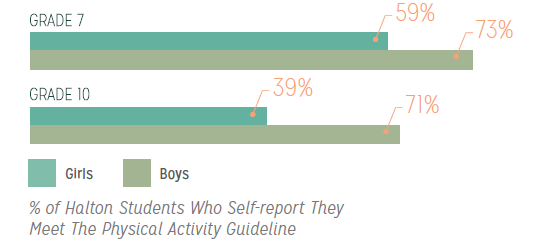 This is what students have said they did in terms of getting the physical education they need for balanced growth. According to the Canadian Society for Exercise Physiology, youth 12–17 years of age require at least 60-minutes of moderate to vigorous intensity activity per day.
In the Halton Youth Survey, two–thirds of Burlington Grade 7s claimed to meet the 60-minute-per-day guideline, but only just over half of Grade 10s claimed to meet the guideline.
Girls in the Halton region were much less likely than boys to report meeting the physical activity guideline, with only four in ten Grade 10 girls meeting the guideline.
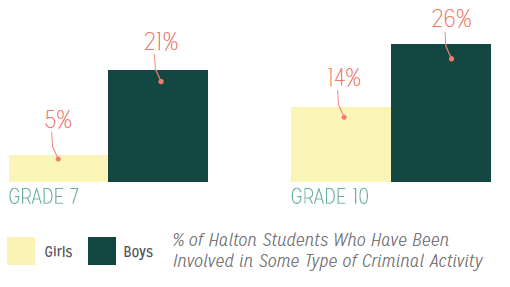 This is not a healthy number. Why in a community where genuine financial need is not pervasive? The Halton Youth Survey, conducted by the Halton Our Kids Network, developed an indicator of involvement in criminal activity based on four self- report questions asking about vandalism, carrying a weapon, selling drugs, and group or gang involvement, and these define what is meant here by “criminal activity”. Note that because this is based on self-report, it includes not only youth accused of crime but also youth who “got away with it”.
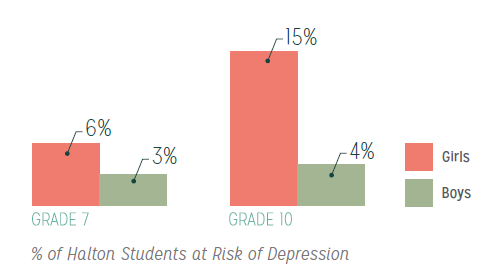 Our girls are at very serious risk: do we understand why and do we have programs to help them deal with the depression they are experiencing? One in five people in Ontario experiences a mental health problem or illness. Because mental illness can affect people in all walks of life, this is as important an issue in comparatively affluent communities like Burlington as it is in other less affluent communities. When you take into account family members and friends, almost everyone is affected in some way.

Mental illness affects people at all life-stages. However, one of the most significant characteristics of the onset of mental health problems is that, unlike many other illnesses, they are more likely to first emerge and affect people early in their lives.
According to a Mental Health Commission of Canada report, the potential negative effects of mental illness on the lives and prospects of young people are considerable:
“Mental disorders are the most common medical conditions causing disability in young people. Most mental disorders begin before age twenty- five and tend to be chronic, with substantial negative short and long-term outcomes. They are associated with poor academic and occupational success, economic burden, personal, interpersonal and family difficulties, increased risk for many physical illnesses and shorter life expectancy.”
Early detection and treatment of mental health problems is vital for the young people in our community and for the future health of our city.
 Access to youth mental health services is not what it needs to be Access to youth mental health services is not what it needs to be
Only one-third of those who need mental health services in Canada actually receive them.
71% of family physicians ranked access to psychiatrists in Ontario as fair to poor.
While mental illnesses constitute more than 15% of the burden of disease in Canada, these illnesses receive only 5.5% of health care dollars.
ROCK reports that due to mental health funding gaps, as of March 2013, youth and families were waiting for just over 1,000 various services they offer. Wait times for these services range from months up to 2 years.
Suicide is the second leading cause of death among young people in Canada. One of the most important causes of youth suicide is mental illness – most often depression, bipolar disorder, schizophrenia, and substance abuse.
The effects of youth suicide go beyond the deceased, impacting those who survive their death – their parents, friends, peers, and communities.
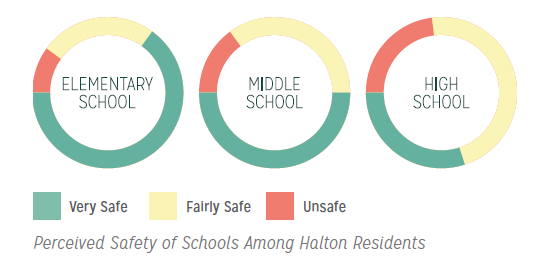 Do our students feel their schools are safe? A survey conducted by the Centre for Addiction and Mental Health found that in response to the question, “In the last 12 months, did you ever seriously consider attempting suicide?”, 7% of Ontario Grade 7s and 12% of Grade 12s answered “yes.”
The Halton Youth Survey asked a somewhat different version of the question, focusing on teens who “sometimes, often or always” had thoughts of suicide in the past 12 months. While the question is somewhat different the results are similar: one in twenty (5%) Grade 7s in Burlington had thoughts about suicide in the past 12 months, increasing to over one in ten (13%) by Grade 10.
Depression is a mood disorder characterized by intense negative emotions and feelings, that negatively impact on people’s lives leading to social, educational, personal and family difficulties.
The Halton Youth Survey created an indicator of being at risk for depression, based on a person saying they “always” or “often” had experienced the following four emotional states in the past week: feeling sad, lonely, depressed, or like crying.
The percentage of Burlington students at risk for depression increases from Grade 7 to Grade 10, and by Grade 10, one in 10 teens are at risk for depression.
This increase in risk for depression from Grade 7 to Grade 10 is occurring primarily among girls. By Grade 10, one in seven girls is at risk for depression.
In the qualitative research project, Halton Youth Voice Road Show (2011), participants suggested the following causes for depression in youth:
Being bullied, which was seen to lead not only to depression but also suicide
Different social groups within a school bullying one another
The fact that sometimes youth were just mean to each other
Technology, since youth don’t actually need to connect to each other on a personal level any more
Images and expectations portrayed in the media
The pursuit of material possessions, with participants saying that it would be better if youth just spent time hanging out instead of shopping
Stress
Not having friends
Being pressured to do drugs
Youth mental health trends at Joseph Brant Hospital
Trips to the hospital emergency department because of a mental health issue represent the tip of the iceberg for youth mental health and substance abuse issues in Burlington. Emergency department visits can occur when mental health or substance abuse issues are undiagnosed, or are untreated, or treatment is not working. Youth visits to the JBH emergency department because of mental health or substance abuse problems show:
Emergency department visits for mental health or substance abuse issues spikes upwards for youth 18–24 years of age.
The annual number of youth under 25 years of age going to JBH emergency because of mental health or substance abuse issues has increased 30% over the last 3 years.
The rate of increase has been even higher among the subset of youth under 18 years of age – showing an increase in emergency visits of 43% over the past 3 years.
JBH operates the Child and Adolescent Psychiatry Consultation Clinic, which provides support to children/youth under the age of 18 years. The case load for the Clinic increased by 16% from 2010–11 to 2011–12, and the average wait time for assessment increased by 31%, to 47 days.
The Community Foundation serves us all well – now the community has to look at the data, talk about it and figure out where we can shore up the weak spots and ensure that we continue to do what we have done well.
Collen Mulholland plans to hold a Roundtable on Mental Health early in 2014. How about ensuring that every grade 10 student in the Board of Education’s high schools be given a copy and make it the focus of a civics class.

 September 24, 2013 September 24, 2013
By Dr. Jeremy Hayman
BURLINGTON, ON. So we all strive to put our best foot forward in raising our children to live the best lives possible, correct? No problem; give them a stable home-life, welcoming and supportive social environment, love, nurturing, guidance, opportunity, compassion and understanding, a balanced active lifestyle and good food. Done, it’s as easy as that. We raise our children the best way we see fit. They grow up happy and healthy, flourish and succeed in life. The next successful generation begins. Agreed?
 Is this child’s mood the result of a problem at school or due to the food that he was fed? Well… let’s see you say that while looking me straight in the eyes and without your fingers crossed behind your back. A simple endeavor, maybe for an outsider looking in at the delicate balancing act of being a parent, but as a parent, it’s often a different story. So where do we begin as well-intentioned parents wanting to provide “the best” for our children from day one? Well, a little of each, if possible, but even that vision can sometimes fall short and derail. It’s not by choice or from lack of trying, but it’s often due to the simple fact of life and its multitude of impressions constantly being offered up to our children.
And we certainly can’t forget about children themselves, they too have a mind and vision of their own! So, short of equipping our children with everything they need in life in order to be healthy and live happily, it seems like there’s quite a division of extremes in fulfilling what we need to do as parents, and to not blame ourselves or point fingers at others in the end. So if you’re not a perfect parent, don’t strive to be one, realize there is no such thing, and still can’t quite seem to fill in the missing pieces, then putting your best “food” forward and feeding your children then, properly, may be a good place to start.
 What is this parent dealing with? An adolescent going through a stage or a child that didn’t eat properly?erft Would you believe it if you were told a bag of candy each night may be the reason your child “decides” not to fall asleep for three or more hours after putting him or her to bed? How about feeding your child a bowl of marshmallows before sending them off to school with no food in sight remaining, only to find out from the teacher that he or she “just doesn’t seem to be listening, cooperating, or focusing throughout the day”? How about being told that feeding your child an overwhelming amount of “midway” “grub” may have been a strong contributing factor to him or her getting sick while on that high velocity amusement park ride? The list goes on.
Well, we believe ourselves when we remain rigid on not feeding our kids too much red meat due to the risk of causing high cholesterol and cardiovascular concerns (which, by the way, I utterly disagree with, so stay tuned for an upcoming perspective on that!). What about that “the tryptophan in the turkey is what put us all to sleep”, or that “the one small piece of raw broccoli must have been what put my child’s digestive system over the edge with that horrible and gassy stomach ache” (of course it wasn’t the other processed food or drink they’re fed on a day-to-day basis…of course not that!). So why is it that we often “believe” to a default that healthy food that affects our children and causes them “strife”, but the unhealthy food we fill our children’s diets with have no effect on them at all? It’s a social and culturally embedded oversight, that I realize, but what we all need to accept is that food, healthy or not, affects us all, children and adults alike.If sugar laden processed food before bed can potentially keep our child up at night, then why do we suppose it stops there? Can’t this exact food wreak even deeper havoc on our children’s personality, emotions, energy, focus and health? Well here’s the answer: It does!
 They aren’t Oreo cookies but that food is healthy. And beyond the overabundance of legitimate literature that supports the effects of food on children’s health as well as the effective use of food as medicine and on health, we, as parents, accepting or not, know that food, to whatever degree, somehow affects our children. So let me tell you this; deprive your child of any food for any great length of time, and tell me he/she won’t waiver on some extent of grumpiness, upset, irritation, tiredness, ‘wildness’ or otherwise (need I go on?). Yet fulfill and satisfy these emotional and biological reactions with food, and what happens? You guessed it; your children’s mood changes, and usually for the better. And here’s a hint, feed your child nutrient dense, tasty, satisfying foods (yes it is very possible to do this!) and guess what? You guessed again, mood improves even more. Feed them calorie dense, nutrient depleted, processed, high sugar foods, mood will artificially improve, for the short-term, before taking a nose dive once again. So what’s the point here? Well if no food causes alterations in our children’s mood (as is clearly evident), then isn’t it possible that food itself may cause changes and effects as well?
 What’s wrong with this picture? It’s not a LED television set?wev <>Our bodies accelerate on an insurmountable number of chemical reactions, all at the mercy of vitamins, minerals and cofactors. Yes, one can argue we physiologically create some of these on our own, however many, essential components, are only created by way of the nutritional content from food. Consider it like this; would you tend toward a healthy, youthful vibrant individual who eats primarily nutritious and healthy food, or prefer to put your money on a person who simply survives on calories alone from any food source to get by? Well the body and its physiology is an amazing entity, but to stress toward the unhealthy option, I mean, eventually, the body will give out, so why give the option to start our children down that path at all? Well here’s how I, as a Naturopathic Doctor, and parent, see it; as parents, we all attempt yet struggle to provide the absolute best for our children’s lives. When pondering the unanswerable parental question of “what am I doing wrong?”, we clearly realize that we cannot possibly change each and every aspect of our child’s lives once the multitude of life’s influences have already begun to unfold. Therefore, what we know from our discussion so far is that food, yes food, can play a vital and impactful role in the lives of our children. We haven’t even begun to scratch the surface of the literature available to us, however when we opt to present our children with more healthy snack and meal options, we know from our discussion so far, that there has to be some sort of effect, and most likely positive, within their lives.
It’s clear, at this point, that within medical science, foods contain many of the precursors to mood, stability, and emotions of our children via the brain and otherwise (take one of serotonins – the “feel good” neurotransmitters precursor, tryptophan, for example), yet we always tend to wonder “why is my child not happy, why do they act the way they do, why don’t they listen, why can I do everything for them yet they still seem not to be assimilating into a happy healthy life?”.
Well, multiple consideration are possible, however although a grade of “A” can be given to all those parents who try so hard to provide as much as they can for their children, there still seems to be something lacking when it comes to overall happiness and health. Ever wonder, just by chance, that one of those missing pieces just may be healthy, nutrient dense food? Unhealthy, non nutritious type “foods” do interfere with the assimilation and use of nutrients from healthy foods, so it’s no wonder an eating plan unfocused on health can interfere with our child’s overall constitution. Our children’s foundation of overall health is built on a few simple yet obvious pillars; and along with enough rest and a proper balance of stress, providing healthy eating options is certainly one of the most effective ways of putting our best foot…and food forward.
 Dr Jeremy Hayman is an Ontario and Board licensed Doctor of Naturopathic Medicine, practicing at Back On Track Chiropractic and Wellness Centre in Burlington Ontario where he maintains a General Family Practice with special interest in Psychiatric as well as Pediatric health. Dr Hayman can be contacted at send me an email Dr Jeremy Hayman is an Ontario and Board licensed Doctor of Naturopathic Medicine, practicing at Back On Track Chiropractic and Wellness Centre in Burlington Ontario where he maintains a General Family Practice with special interest in Psychiatric as well as Pediatric health. Dr Hayman can be contacted at send me an email

 September 25, 2013 September 25, 2013
By Pepper Parr
BURLINGTON, ON. It has come to this: we now have a Cyber Tip Awareness Day when we focus on the sexual exploitation that is perpetrated against our children when they use the internet.
 There is some help in understanding how the pedophiles lure your child. Cybertip.ca is Canada’s national tip line for reporting the online sexual exploitation of children. Since its inception in September 2002, it has responded to more than 94,000 child sexual exploitation reports. In Halton, ten such tips have been investigated since 2012.
Last year, on the 10th anniversary of Cybertip.ca, the Canadian Centre for Child Protection announced the inaugural Awareness Day to focus on this critical service for reporting the online sexual exploitation of children and for obtaining important educational material.
 What is sextexting and how do you prevent your children from getting involved? On September 26th police services hope to raise the awareness of the web site where people can report their concerns about a child being sexually exploited and encourage them to access ‘cybertip.ca’ for a new educational booklet entitled, ‘Parenting Tweens and Teens in a Digital World’.
The web site is worth a few minutes of your time.
The Halton Regional Police Service is a member of the Provincial Strategy to Protect Children from Sexual Abuse and Exploitation on the Internet.

 September 22, 2013 September 22, 2013
By Staff
BURLINGTON, ON. It was the 4th Annual. They shut down the lower part of Brant Street to let it happen and happen it did. The Amazing Bed Race, a fund-raiser for the Joseph Brant Hospital’s redevelopment saw a number of new entrants. Smith Funeral Homes took the Best Entry prize for an imaginative entry.
 They called themselves the Overtakers and along with earning the Best Entry prize they got into the quarter finals as well. The knocked off the Mike Wallace Tories in an elimination race only to be knocked off by the Jane McKenna Tory’s in the next elimination. Great fun. Not only did the “vehicle” tell the corporate story but it made it to the quarter finals as well. Calling it a bed was a bit of a stretch though.
The crowd for this event – well it could have been bigger because it was good entertainment. The teams push and they push hard. As the elimination races began to take place there was a run off between “beds” from two landscaping outfits – and they were competing in every sense of the word.
The event is a fund-raiser but one got the impression there was a lot of corporate image on the line. The Tories were all over this event as well. MP Mike Wallace, looking very trim, lead his team while Jane McKenna, who was away at a Tory provincial convention, was led by a team done up in major blue costumes.
There wasn’t a Liberal or a New Democrat to be seen. The Greens weren’t to be seen either.
 The McKenna Tory team, in their sleek blue costumes, edged out the Smith Funeral Overtakers in the elimination races. 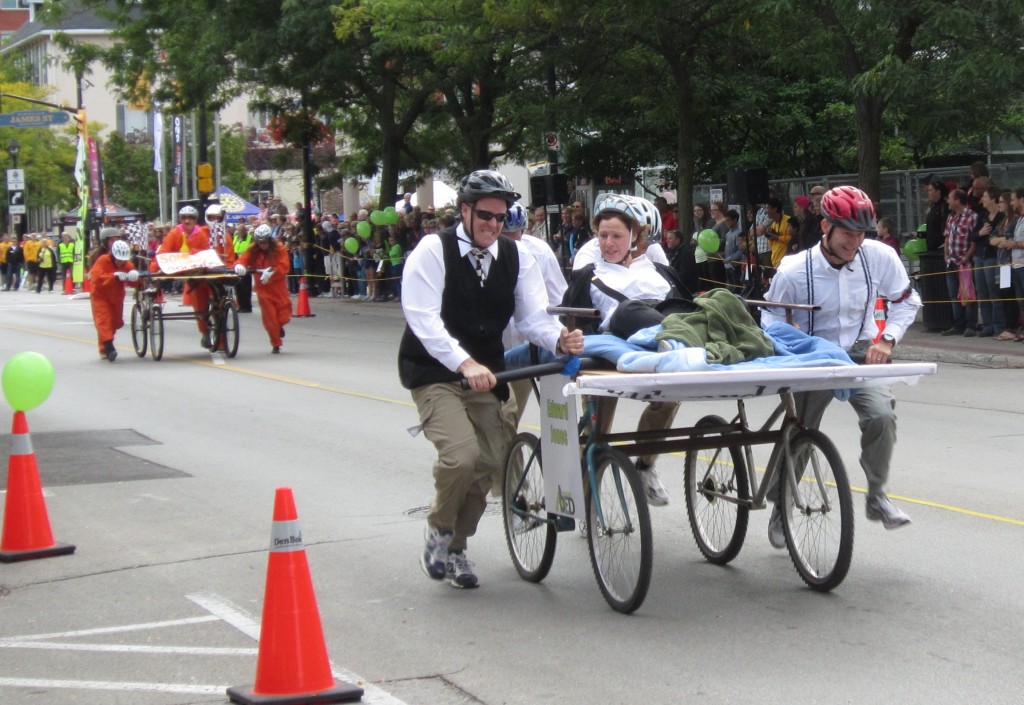 This one wasn’t a race – it was more of a route. The patient looks pretty concerned about the runner 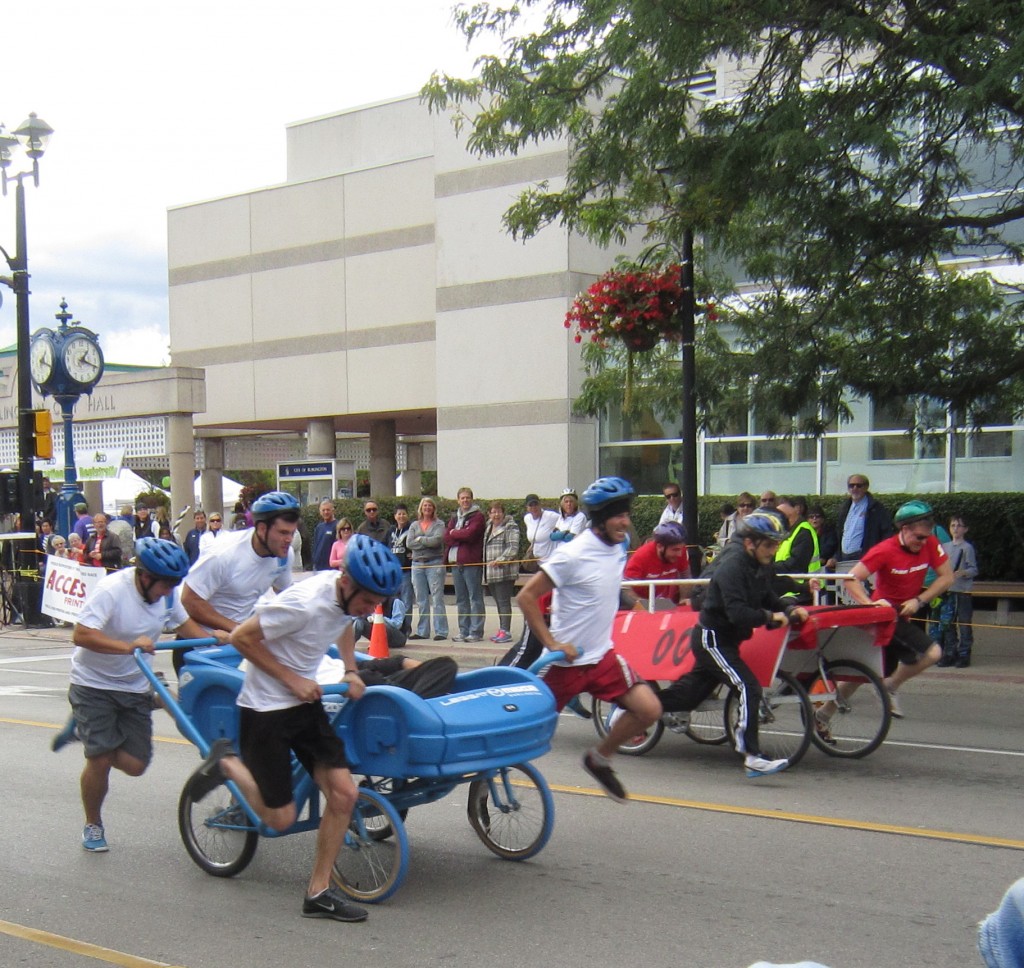 Leggat Mazda had to push past the 007’s to get themselves to the finals – which they did.  The BayHawks Soccer Team beat out the team from the hospital and went on to give the automotive people who were eventually the two finalists a very good run.  Mike Wallace has probably never run as hard in his life. Valiant effort but the Overtakers laid the Wallace team to rest. 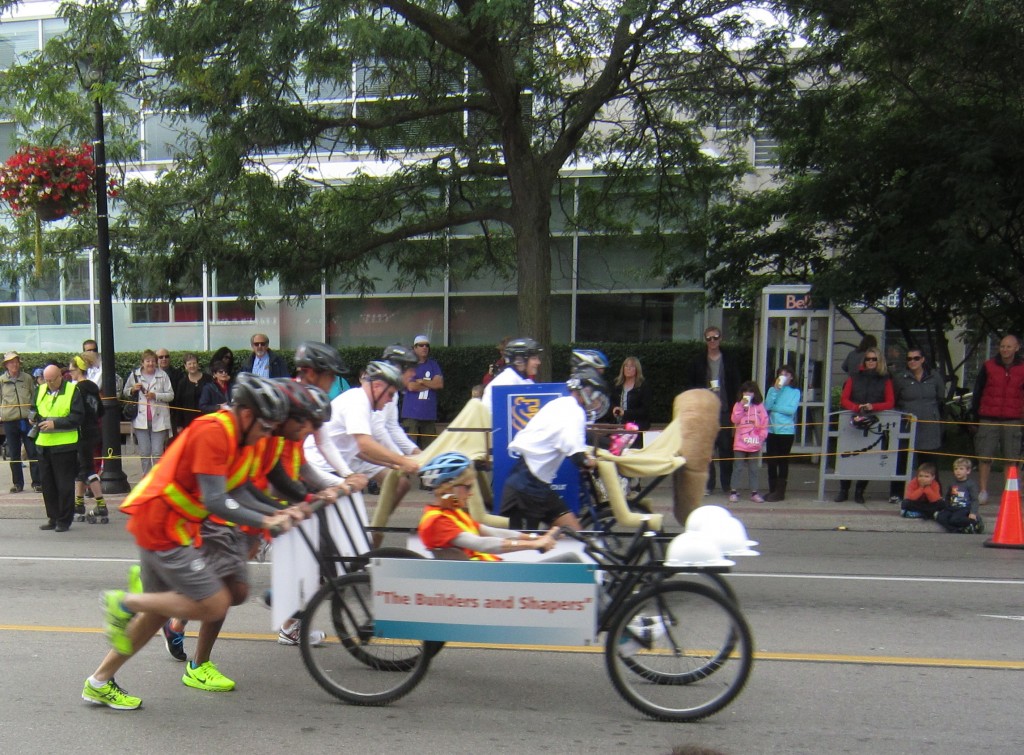 That looks like a tie – but it didn’t end that way. The bank lost out the hospital team.  The tone for the event was set by the judges who apparently didn’t take themselves all that seriously.  If you pushed a stroller – you were a winner.  Good clean starts 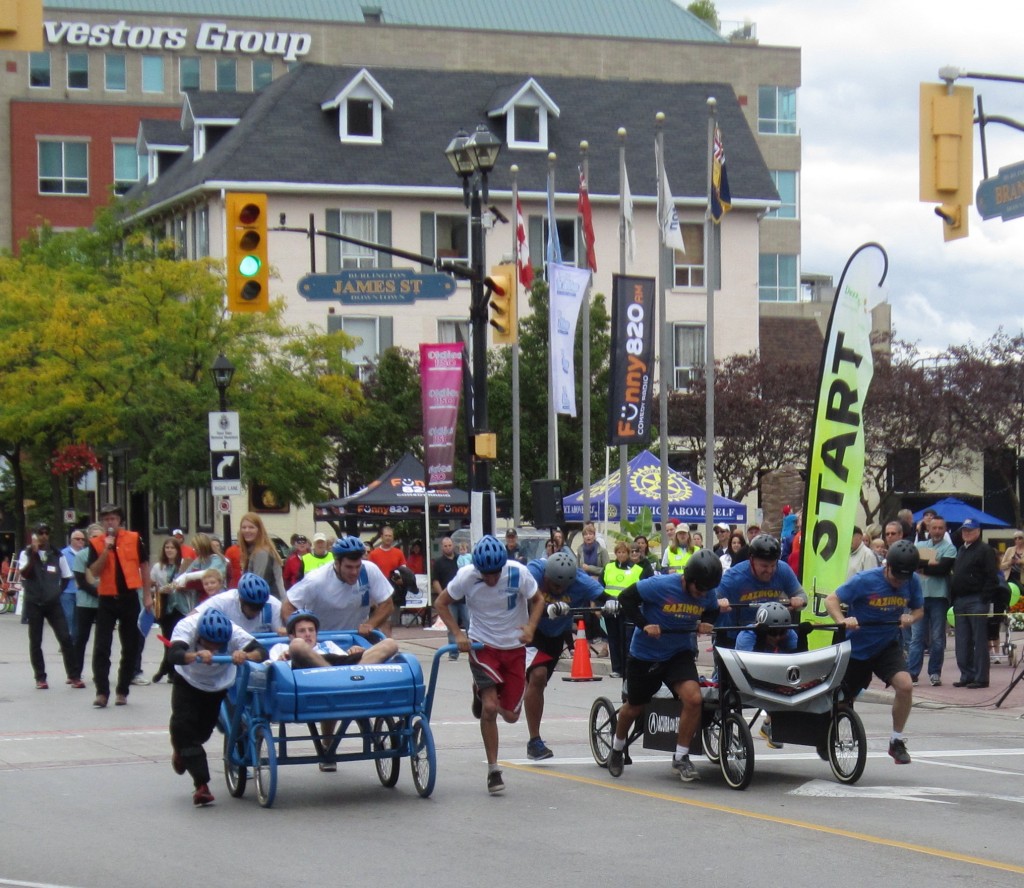 The finalists getting out of the starting gate. Acura on Brant beat Leggat Mazda in a well run race. The races begin with time trials. Each “bed” runs the short course twice, which then sets them up for the races that lead to one final event which for Burlington this year came down to two automotive dealers racing against each other. The McKenna bed and the Smith Funeral bed hung in right to the end.
Good clean fun – with a camera crew coming uncomfortably close to being wiped out on more than one occasion.
The rules require each bed to stay in its lane, which, given the steering mechanism on these “beds”, made that somewhat difficult.
With four years’ experience behind then – this could become an even more significant event, with the high schools running against each other, the political parties fighting for supremacy and the city’s corporate sector out there in force.
Could city hall challenge the Region? Could Roseland challenge Aldershot? Could some of the golf clubs challenge one another. Lots of room for growth on this one.
The Stroller races were a delight – there was one girl who figured out quickly how to get her stroller up that course quick,quick, quick. She tilted her stroller back onto the rear wheels and let it fly.
For the 2013 Amazing Bed Race it came down to Acura on Brant beating LeggatMazda in the final race.
The event is presented by Scotiabank and organized by the Joseph Brant Hospital Foundation and the Rotary Club of Burlington North. In its first three years the event raised over $272,000.
Teams are formed and either makes their own bed or rents a bed from the organization then they get out and do their fund raising.

 September 20th, 2013 September 20th, 2013
By Staff
BURLINGTON, ON. These days you just never know – do you? Conservation Halton issued the following Watershed Conditions Statement – Flood Outlook today at 3:30 p.m.
Environment Canada is advising a period of extended rainfall over the next 24 hours due to the train of a slow-moving cold front. The rain is expected to begin this evening and continue overnight and into tomorrow morning. Rainfall accumulations of 15 to 25 mm are expected across the watershed along with the potential for some isolated thunderstorms which could increase the rainfall values.
 One of the several reservoirs in the Region:  As a result of the rainfall our rivers and streams will result in higher than normal water levels and flows, creating dangerous conditions. Widespread flooding is not currently anticipated. Our reservoirs are still in range of our seasonal levels and have storage capacity available. As a result of the rainfall our rivers and streams will result in higher than normal water levels and flows, creating dangerous conditions. Widespread flooding is not currently anticipated. Our reservoirs are still in range of our seasonal levels and have storage capacity available.
Conservation Halton is asking all residents and children to stay away from all watercourses and structures such as bridges, culverts and dams. Elevated water levels, fast flowing water, and slippery conditions along stream banks continue to make these locations extremely dangerous. Please alert children in your care of these imminent dangers.
Conservation Halton will continue to monitor stream and weather conditions and will issue further messages as necessary.
This Watershed Condition Statement will be in effect through to Sunday September 22, 2013.
Note: A Watershed Safety Statement – Flood Outlook is an early notice of the potential for flooding based on weather forecasts calling for heavy rain, snow melt, high wind or other conditions that could lead to high runoff, cause ice jams, lakeshore flooding or erosion.

 September 16, 2013 September 16, 2013
By Staff
The Burlington Terry Fox Run took in over $72,000 which slightly ahead of last year. The final tally, won’t be known for several weeks but there were more than 1000 participants and 140 volunteer.
 Casey Cosgrove talks with Deb Tymstra about the crowd he brought with him to the 2013 Terry Fox Run. 
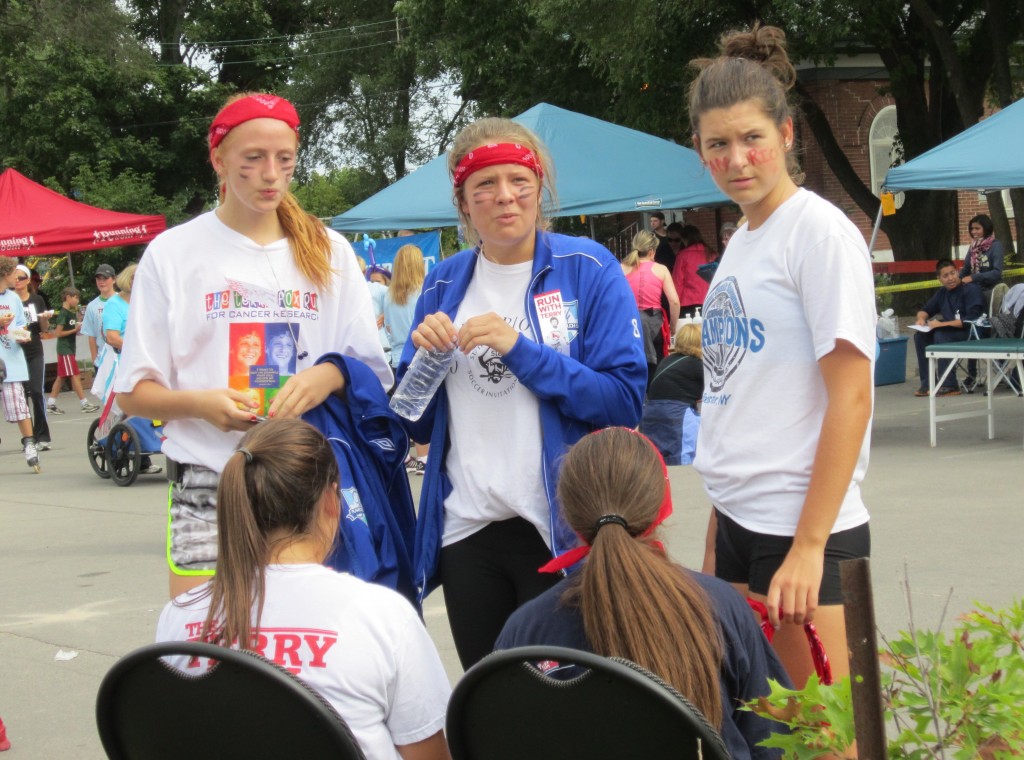 Run Warriors – it is this age group that shows up year after year.  When they burn up the energy – the need to refill those tanks. Hot dog stand was where most people ended up.  when you cross that finish line – a cup of water is real welcome. The Terry Fox organization in Burlington covers all the bases.  The Run done – this family re-groups and gets ready to head home – a good job done and some lessons learned.  The Remembering Board tells a large part of what the Terry Fox Run is all about.  A really special team – Casey Cosgrove and his supporters. Don Carmichael, chair of the 2013 Run said he thought the atmosphere was great and operations were smooth.
The changes to the course and parking seemed to have worked well. “We disappointed a few people” said Carmichael, “when we eliminated bikes but the big crowd just makes it impossible to have them.” The organization is already thinking about how to keep growing and improving the Run Day experience. We are looking forward to next year as we build toward the 35th anniversary in 2015.
The organization added a feature this year that many found touching. Deb Tymstra did live interviews with people on the Beachway Park grounds giving them an opportunity to tell their story; why they were taking part in the Run and what it meant to them.
In July 1980 Terry Fox ran through Burlington. He left deep foot prints and every year, for a little while, we get to follow those foot prints and run with him again. Sunday morning more than 1000 Burlingtonians followed those footsteps and raised more than $72,000 for Cancer Research, slightly ahead of last year.

 September 16, 2013 September 16, 2013
By Staff
BURLINGTON, ON. It boiled down to a battle for third place and BurlingtonGreen did everything they could to hold that position.
The Jamieson Vitamins Call for the Wild was a race between five organizations for a share of the $100,000 prize.
 Early in the contest the Vancouver team was racing ahead but Burlington and Calgary caught up and battled for third place while Nova Scotia and Quebec went on to take the top two spots. Burlington Green looked at the competition and at first thought the Vancouver Aquarium was going to be the stiffest group to go up against but as it turned out Nova Scotia’s Hope for Wild Life, and McGill Universities Bird Sanctuary began to show as the clear leaders about a third of the way into the month-long contest.
 It was a stiff battle between Burlington and Calgary for the third spot in the $100,000 contest. The last week was a back and forth between Burlington and Calgary’s Wildlife Rehabilitation for that third spot.
Burlington put their membership out into the Terry Fox Run on Sunday where they were able to collect the name and email addresses of about 100 people who they then entered into the contest Facebook page and that basically did it for Burlington who racked up 11,042 votes to pull in $12, 576.
Calgary had 10,980 votes and took $12,505
Michelle Bennett of Burlington Green called it an amazing last day response from a very supportive community and we are so thankful to them.”
BurlingtonGreen added a local incentive and put a bicycle from Mountain Equipment Coop into the draw. Anyone who voted was able to slide over to the Burlington Green website and enter their name into the draw for the bike. The winner of that draw will be announced later this week.

 September 15, 2013 September 15, 2013
By Pepper Parr
BURLINGTON, ON. He will stand there quietly, chat with some of his many friends as he looks over the crowd. Many lined up at the registration table while others do their stretching exercises to get ready for the Run – The Terry Fox Run for Cancer Research.
It was 33 years ago when Greg Pace organized the first run. “I was all gung-ho at the time – everyone was. Terry Fox had run his Marathon of Hope and had to give up – but what a lot of people didn’t fully realize was the kid was running the equivalent of a 26 mile marathon every day. That was a phenomenal achievement and he did it with just the one good leg.”
There isn’t a Canadian alive today who saw that young man work his way from the east coast and through hundreds of Ontario cities, who will ever forget that little hop Terry Fox used to propel himself forward.
 Greg Pace with one of the Iron Maidens. And for Greg Pace, who lost his wife Kim to cancer, that is what it is all about – propelling ourselves forward. The Terry Fox Run started out at Sherwood Forest Park back in the 80’s where all we could set up was a 10k run” explained Pace. “We moved the event downtown but that didn’t work out – the priests at the downtown churches asked us to try and keep it quiet and not use the megaphones – they wanted to be able to finish their church services.”
“I started out by calling the Canadian Cancer Society but they didn’t seem to have their act together so we just organized the event and it took place. It was a really small committee; Fran Agnew who was working with Rob MacIsaac at the time and Chuck Dooley who is now teaching Phys Ed at Notre dame High school.
We ran the event for seven or eight years until others were able to take it over – and we now watch as young people grow the event. It`s great to see it continue.
Pace who has been around fitness all his life spent a couple of years at the Cedar Spring Health Club, was the man who opened up the Goodlife Health Club at Burlington Mall. Worked for a while at the Fitness Institute – one of the first operations totally committed to fitness improvement when it wasn’t seen as a business opportunity.
After working for others Greg decided to strike out on his own and formed Pace Performance where he has settled into working with people who want to prepare for endurance events – Triathlons and Iron Man events. He formed the Iron Maids that his wife was part of when she was an active athlete.
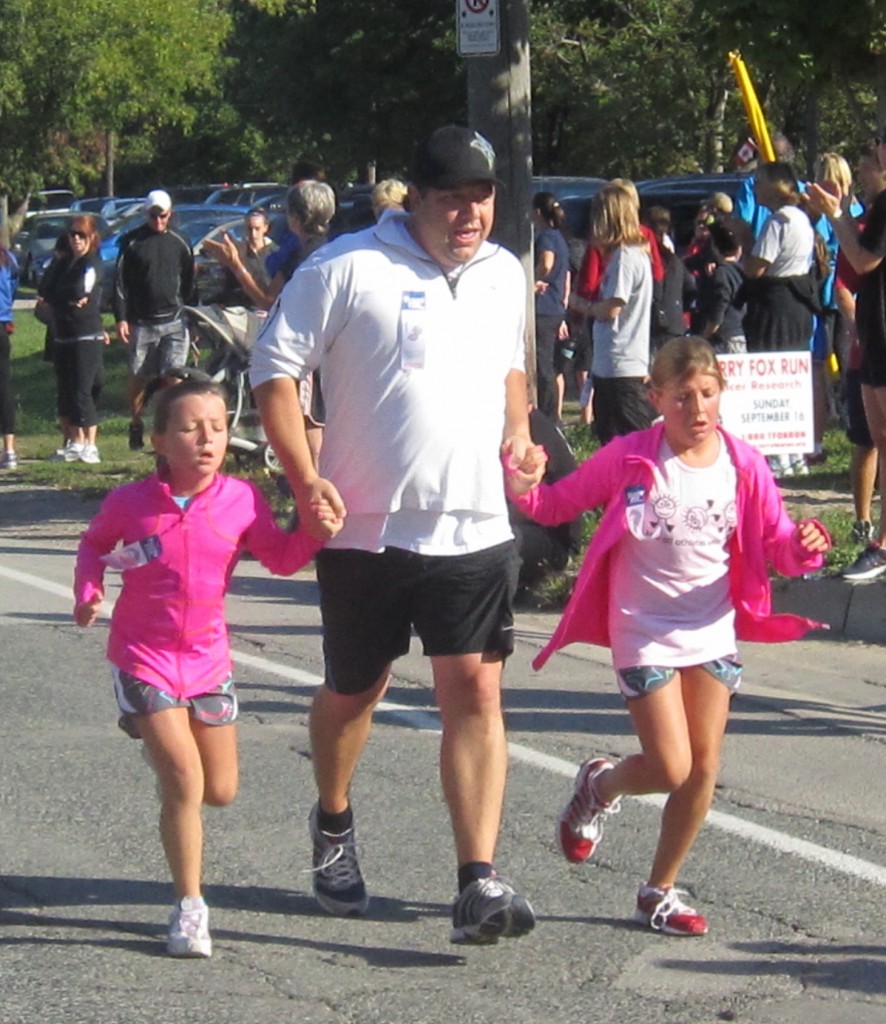 Doing better than you expected with children there – every step of the way. When asked what he thinks now as he watches people doing the Run, Pace said it was hard to pin that thought down. “There is nothing better than watching someone do something that is better than they thought they could do” and “nobody thinks the run was a bad idea when they are doing that last 50 metres” he said. “Everyone comes away with a sense of accomplishment”, he added.
“In the beginning some people thought the Run was part of a wave; something that would peter out over time but today it is bigger and better than it ever was – it certainly has staying power – but then that’s what Terry Fox brought to the Run that he did wasn’t it, said Pace.
The Mayor of a city has the privilege of selecting individuals for special recognition. Rick Goldring recently presented Greg Pace with The Civic Recognition Award.
Greg, said the Mayor, “has been involved and donating his skills and time for various charitable and fitness organizations for over 30 years. Most notably, the Moon in June Road Race which in the last 20 years has raised over $450,000 for local charities and brings thousands of participants and spectators to the Burlington downtown core.”
“For the past four years the Halton Trauma Centre has received the proceeds from this race, raising over $100,000 to help provide assessment and treatment to children and adolescents who have suffered from abuse or neglect.”
Add the Terry Fox Run to that and you have quite a set of accomplishments. Think about that as you take part in the Terry Fox Run later today.

 September 8, 2013 September 8, 2013
By Staff
BURLINGTON, ON. A 42-year-old female lost her balance near a lookout in an area on top of the escarpment and was pronounced dead at the scene early this afternoon.
The victim’s family has asked that the identity not be released.
At approximately 1:00 p.m. on September 8th, 2013, Halton Police received a 9-1-1 call about a hiker that had fallen at the Mount Nemo Conservation Area. Officers responded, along with members of the Burlington Fire Department and Halton EMS.
The victim was located at the bottom of a cliff in very rugged terrain. Police officers performed CPR on the woman for a significant amount of time, until relieved by EMS personnel. The victim was eventually pronounced dead at the scene.
The Burlington Fire Department assisted with the recovery of the victim from the base of the cliff.
The investigation has revealed that the 42-year-old female victim lost her balance near a lookout in an area on top of the escarpment.
A post-mortem examination will be conducted on September 9th 2013 at the Hamilton General Hospital.

 September 6, 2013 September 6, 2013
By Staff
BURLINGTON, ON. If the weather we are having today holds for the weekend there won’t be too many people in the waters of Lake Ontario at the foot of the city – and that’s probably a good thing because the Regional Health people tell us the water is not all that safe to swim in.
 Swimming in this city isn’t the smartest idea this weekend.

 Jeremy Hayman, Doctor of Naturopathic Medicine (ND) will be writing a regular column for the Burlington Gazette. ND is a professional medical designation earned following an undergraduate pre-medical degree and four years of post-graduate medical training at a fully accredited (CNME) naturopathic medical college. All licensed Naturopathic Doctors practicing in Ontario have been fully regulated under the Drugless Practitioners Act.Upon completion of regulatory board examinations, Naturopathic Doctors, as primary health care providers, are required to maintain their competency by meeting continuing education requirements as well upholding naturopathic medical association standings. Jeremy Hayman, Doctor of Naturopathic Medicine (ND) will be writing a regular column for the Burlington Gazette. ND is a professional medical designation earned following an undergraduate pre-medical degree and four years of post-graduate medical training at a fully accredited (CNME) naturopathic medical college. All licensed Naturopathic Doctors practicing in Ontario have been fully regulated under the Drugless Practitioners Act.Upon completion of regulatory board examinations, Naturopathic Doctors, as primary health care providers, are required to maintain their competency by meeting continuing education requirements as well upholding naturopathic medical association standings.
In comparison to a Medical Doctor designation (MD), a Naturopathic Medical designation (ND) is comprised of an equivalency in term of basic science education hours. Where an MD focuses more time on pharmaceutical medicine, NDs also study pharmacology and its drugs, however extensive training in natural medicine (such as botanical, Oriental, nutritional, physical, and homeopathic medicine as well as lifestyle, counseling and herb-drug interactions) is adjunctively studied as well. In Ontario, a naturopathic doctors is considered a primary care physicians. NDs cannot prescribe pharmaceutical medications in Ontario as MDs are able to, and are only covered under extended health plans and not OHIP billing, however they are able to employ conventional laboratory testing and diagnostic imaging as necessary.
September 5, 2013
By Dr. Jeremy Hayman
BURLINGTON, ON. September 5, 2013 When it comes to understanding the meaning of the popular phrase “too much of a good thing”, we all too often overdo our ideal balance by taking this idiom to the extreme. It’s common practice to believe that if something is healthy, then more is better. We have all experienced, in one way or another, too much of something we believe is “good” often times turns out not to be as “good” or as pleasant as we first thought.
 There are limits – or at least there should be some limits we observe. How many of you have ever basked under the healthful vitamin D filled sunrays on a warm summer day only to regretfully suffer the agonizing (and burning) result of “too much of a good thing”? Ok, so we agree, in our own unique and sometimes retrospective way, too much of a “good thing” may in fact result in the complete opposite of what we originally thought. This consideration has forced us to accommodate moderation into our daily lives, correct?
Well, not always in reality, but the true meaning and moral does allow us to consider the wise choice that everything in life should be experienced in balance. Although, when it comes to natural health and contributions to natural health, I sometimes, beg to differ. When it comes to balance and happiness within our children’s mental health, I beg to differ without question.
The mental health status of children constitutes a need for balance, however the more happiness, balance and support toward a child’s mental health, argument cannot be justified that too much of a good thing is ultimately “too much”. Mental health of children is of utmost value, and the more support that can be provided naturally, the better. So let’s talk mental health within our most impressionable population, and let’s learn what it takes to naturally keep the mental health of our children balanced.
According to Health Canada, one in five Canadians will experience some type of mental illness over the course of their lifetime, many of whom will never fully recover. The other four will have a friend, family member, or colleague who will experience a mental health issue. Children, within this statistic, are sadly, not excluded. So what is sound mental health as it pertains to our children and how can the balance toward such a “good thing” be realized? Mental health in children refers to the mental state of how one thinks about, feels, associates, and responds to the world within and around him/her. Depression, anxiety, general stress, attention deficit, autism, panic, and bi polar are mental health states but to name a few. Achieving consistent happiness, positive adaptation, awareness and balanced thought and feeling is what exemplifies mental health to its ultimate degree. When mind and body become occupied and clouded with an ongoing interference of thoughts and feeling, mental health state begins to decline. Once it acclimatizes to this state of mal-adaptation, psychiatric “disorder” may inevitably ensue. Continued psychiatric distress does nothing more than lend itself to a continued spiraling of ill-health, physically, mentally and otherwise.
 Interestingly enough, many children affected are being diagnosed simply as an illness due to genetics, “chemical imbalance”, or “predisposition” (which by the way isn’t necessarily an accurate preceding diagnosis at all). It is, however, becoming more and more striking, yet accepted, that mental health issues can also arise from psychosocial stress, unhealthy diets and food production, environmental and toxin influences, as well as from the use (and overuse) of pharmacological medications. Although the contributing source which underlies how a child feels mentally and emotionally may not always be undeniably determined, we do know that focusing on the basics will help make a child feel better. Interestingly enough, many children affected are being diagnosed simply as an illness due to genetics, “chemical imbalance”, or “predisposition” (which by the way isn’t necessarily an accurate preceding diagnosis at all). It is, however, becoming more and more striking, yet accepted, that mental health issues can also arise from psychosocial stress, unhealthy diets and food production, environmental and toxin influences, as well as from the use (and overuse) of pharmacological medications. Although the contributing source which underlies how a child feels mentally and emotionally may not always be undeniably determined, we do know that focusing on the basics will help make a child feel better.
When a mental predisposition or illness in a child is typically diagnosed, there is a tendency not to turn to creative solutions for support, but rather to quickly medicate our children. Medication does have its place, however, from a natural and primary care perspective, what should be done is to address a child’s environment, parental stress, nutrition, lifestyle, and an overall comprehensive evaluating view of a child’s life. As stated, medication does have its place (pending individual circumstances, no doubt), however by simply medicating our children as first line treatment, in all circumstances, what’s being done is simply disempowering children, inducing a biochemical imbalance in the brain (not altering or fixing one) and simply guiding children into believing that coping and self-regulating cannot be accomplished without drugs. If all aspects of a child’s life is addressed, medication may still be required, but potentially at a later date, a lower dose, for a shorter time, and may in fact create a better result, given all other supporting aspects have been addressed.
So how exactly do we treat a mental illness in a child? First and foremost, a professional medical assessment needs to be performed in order to determine where along the “spectrum” a child’s mental state rests. Many diagnostics are determined using a firm array of clinical signs and symptoms, depending of course on the mental state in question. With anxiety for example, a child’s anxiety and worry state would need to be associated with at least three of seven symptoms (sleep disturbance, easy fatigue, and being “on edge” for example). And more importantly to note, just because a child “displays possible symptoms”, doesn’t automatically conclude a mental illness is at hand, however, it also does it mean that there is not. A whole picture approach would need to be considered, as many symptoms of mental health illness can very well be generalized symptoms in and amongst themselves. Yet, a single symptom can also be a key clue that an initial mental illness may be at play. So rather than diagnosing or treating a mental illness based on a limited clinical picture, a comprehensive and total life picture of the child, as a person, needs to be considered and sought out (as addressing a person and not just an illness, is truly what medicine and its management should be all about).
 Vast approaches to mental health can be employed, however utilizing a comprehensive medical approach, encompassing natural sound and evidenced based medicine, combined with primary care practice often works best. Once a mental status has been determined, natural support in the way of botanical medicine, correction of nutritional deficiencies and a therapeutic approach to diet, stress, and environment, in conjunction with primary health care can be successfully accomplished. Realizing and diagnosing a mental illness in a child at any age is not something that sits well with anyone. The good news is that it doesn’t have to be a life sentence of unhappiness, instability or illness either. The evidence is there, that natural medicine works, and by incorporating the essentials in terms of what makes our children better, success with mental illness can be realized. Vast approaches to mental health can be employed, however utilizing a comprehensive medical approach, encompassing natural sound and evidenced based medicine, combined with primary care practice often works best. Once a mental status has been determined, natural support in the way of botanical medicine, correction of nutritional deficiencies and a therapeutic approach to diet, stress, and environment, in conjunction with primary health care can be successfully accomplished. Realizing and diagnosing a mental illness in a child at any age is not something that sits well with anyone. The good news is that it doesn’t have to be a life sentence of unhappiness, instability or illness either. The evidence is there, that natural medicine works, and by incorporating the essentials in terms of what makes our children better, success with mental illness can be realized.
Functioning of a child to the degree which satisfies society’s expectations alone is not the element to success. Fundamentally supporting a child’s mental health issue(s) at its root IS the only management tool to propel mental and emotional stability from a life of uncertainty to that of making “too much of a good thing” worth living.
Dr Jeremy Hayman is an Ontario and Board licensed Doctor of Naturopathic Medicine, practicing at Back On Track Chiropractic and Wellness Centre in Burlington Ontario where he maintains a General Family Practice with special interest in Psychiatric as well as Pediatric health. Dr Hayman can be contacted at drjeremynd@gmail.com

 September 4, 2013 September 4, 2013
By Pepper Parr
BURLINGTON, ON. They’re back in school, and the whole tempo of the city changes. All those people with community wide programs are holding their committee meetings and timetables with task assignments are being handed out.
One of the signature events for Burlington is the Terry Fox Run for Cancer Research. The number of people who run is well over 1000 – 1200 last year. They raised over $80,000 Each year the number grows and each year more people find personal meaning in the run – many choose to walk and use the occasion to think about and appreciate someone they lost to cancer.
The event takes place this year on Sunday, September 15th.
Burlington has been doing this for 33 years and in that time has collected more than $1.5 million for cancer research.
 Part of the crew that did the door to door distribution of flyers to promote the Terry Fox Run.
Kevin Slovacek, Katherine, Kevin and Jack
The Gazette did some joint promotional work with the Terry Fox Run people and distributed more than 5000 flyers door to door in the city announcing the run and introducing people to the Gazette.
We certainly saw a significant bump in readership and assume there will be a corresponding bump in the number of people who take part in the Run.
 Daughter Kate, who now wants to be called XXX, on the lft with wife Bryana centre and Casey on the right figuring out which streets in Alton were covered. That distribution effort got done by Casey Cosgrove and his family. They were out on the streets, of Alton Village for the most part, because this is a new community with people from Mississauga and Milton moving in.
The people organizing the run wanted to include this community and tell them about this signature event that comes close to defining Burlington.– we will see how many of them decide to take part.
Cancer is a large part of the Cosgrove household. Casey has been battling this disease for a number of years and has taken part in a number of trial medication programs. He went as far as he could at the Juravinski Cancer Centre and is now on a program at the Princess Margaret Hospital in Toronto.
Casey doesn’t know what the outcome is going to be. He lives each day being who he is: expecting the best and prepared for the worst.
Last year there was a Cosgrove contingent in the Terry Fox Run and this year Casey took on the task of getting more people out.
A former candidate for public office (Ward 5), Cosgrove will tell you that had he won in 2006 Rick Goldring wouldn’t be Mayor today. The Mayor doesn’t see it quite that way.
Casey Cosgrove is showing this city what it means to give back – when you barely have enough to get by on yourself. His being out on the street in blazing sunshine, walking briskly from door to door while his wife and their daughter Kate, who has advised the world that she now wants to be known as Katherine, were doing the same thing a couple of streets, over is what Casey believes he has to do.
He believes fervently that there s a cure for cancer but knows all too well that it costs a fortune to pay the scientists and the researchers to find that cure.
We have made huge progress but the battle is not over.
Be part of that battle – show up on the 15th – at the Pavilion on the Beachway. Starts at: 11:00.

 August 29, 2013 August 29, 2013
By Pepper Parr
BURLINGTON, ON. Halton Region’s Health Department is advising residents to avoid swimming and wading in the waters at Beachway Park and LaSalle Park in Burlington and Bronte Beach Park in Oakville because blue-green algae (BGA) have been identified at these locations.
Residents are also advised not to eat fish caught in these areas and not to let pets play in or drink the water.
Halton’s drinking water is not affected and continues to be safe.
 Blue green algae tends to float near the surface and wave action brings it close to shore. Its colour makes it very easy to identify. Exposure to the algae causes skin irritation. Some BGA have the potential to produce toxins or skin irritants. Adverse health effects from BGA are mainly related to ingestion of BGA-contaminated water or skin irritation and itching from skin contact with BGA-contaminated water.
 Wave action brings the algae close to shore. As a precaution, signs have been posted to warn beach users.
“Conditions at the beaches can change from one day to the next,” stated Dr. Monir Taha, Halton Region Associate Medical Officer of Health. “We encourage residents to visit our website for up to date information.”
If you have been swimming or wading in these waters and feel unwell, please visit your physician or walk-in clinic.
 Hamilton put up these lines in an attempt to hold back the algae in parts of their waterfront. The picture was tweeted from Hamilton Algae is something that is in the water most of the time. Run off from heavy rains will flush phosphates into the streams and hot sunshine causes the algae to breed just that much faster.
It’s natural – its there – at times it just gets a little out of control.
For more information, dial 311 or visit the Region’s website.

|
|






























 gh it all. Why position ourselves to have to fight these bugs, when we can utilize and take advantage of their unwanted effects to better our overall health?
gh it all. Why position ourselves to have to fight these bugs, when we can utilize and take advantage of their unwanted effects to better our overall health? 


 The term “dietary default” refers to a multitude of references when it comes to our association and relationship with food. Within the context of this discussion, I’m referring to those who consume foods without truly thinking about what or why they consume the foods they do. And out of fairness, it also stoutly refers to foods the average population so simply shy’s away from and leaves out. To delve into this even further, it refers to those who almost automatically follow a routine eating regimen, eat the same foods week to week, and most importantly, rarely, if ever, truly think about the impact of what they eat, or how it will ultimately consume them in the short and long haul with respect to health.
The term “dietary default” refers to a multitude of references when it comes to our association and relationship with food. Within the context of this discussion, I’m referring to those who consume foods without truly thinking about what or why they consume the foods they do. And out of fairness, it also stoutly refers to foods the average population so simply shy’s away from and leaves out. To delve into this even further, it refers to those who almost automatically follow a routine eating regimen, eat the same foods week to week, and most importantly, rarely, if ever, truly think about the impact of what they eat, or how it will ultimately consume them in the short and long haul with respect to health. 
 With the overwhelming amount of mass media making use of its privilege to feed us its messages on what/what not to eat, how to eat, when to eat, why to eat, where to eat etc., it’s no wonder there’s an endless endeavor to try and figure it all out. Let alone pressures from others on our way of eating, we end up living in a whirlwind of relentless persuasions about what is best for ourselves and others.
With the overwhelming amount of mass media making use of its privilege to feed us its messages on what/what not to eat, how to eat, when to eat, why to eat, where to eat etc., it’s no wonder there’s an endless endeavor to try and figure it all out. Let alone pressures from others on our way of eating, we end up living in a whirlwind of relentless persuasions about what is best for ourselves and others.










 The Canadian Institute for Health Information tracks the performance of
The Canadian Institute for Health Information tracks the performance of

































 As a result of the rainfall our rivers and streams will result in higher than normal water levels and flows, creating dangerous conditions. Widespread flooding is not currently anticipated. Our reservoirs are still in range of our seasonal levels and have storage capacity available.
As a result of the rainfall our rivers and streams will result in higher than normal water levels and flows, creating dangerous conditions. Widespread flooding is not currently anticipated. Our reservoirs are still in range of our seasonal levels and have storage capacity available.



















 Interestingly enough, many children affected are being diagnosed simply as an illness due to genetics, “chemical imbalance”, or “predisposition” (which by the way isn’t necessarily an accurate preceding diagnosis at all). It is, however, becoming more and more striking, yet accepted, that mental health issues can also arise from psychosocial stress, unhealthy diets and food production, environmental and toxin influences, as well as from the use (and overuse) of pharmacological medications. Although the contributing source which underlies how a child feels mentally and emotionally may not always be undeniably determined, we do know that focusing on the basics will help make a child feel better.
Interestingly enough, many children affected are being diagnosed simply as an illness due to genetics, “chemical imbalance”, or “predisposition” (which by the way isn’t necessarily an accurate preceding diagnosis at all). It is, however, becoming more and more striking, yet accepted, that mental health issues can also arise from psychosocial stress, unhealthy diets and food production, environmental and toxin influences, as well as from the use (and overuse) of pharmacological medications. Although the contributing source which underlies how a child feels mentally and emotionally may not always be undeniably determined, we do know that focusing on the basics will help make a child feel better.  Vast approaches to mental health can be employed, however utilizing a comprehensive medical approach, encompassing natural sound and evidenced based medicine, combined with primary care practice often works best. Once a mental status has been determined, natural support in the way of botanical medicine, correction of nutritional deficiencies and a therapeutic approach to diet, stress, and environment, in conjunction with primary health care can be successfully accomplished. Realizing and diagnosing a mental illness in a child at any age is not something that sits well with anyone. The good news is that it doesn’t have to be a life sentence of unhappiness, instability or illness either. The evidence is there, that natural medicine works, and by incorporating the essentials in terms of what makes our children better, success with mental illness can be realized.
Vast approaches to mental health can be employed, however utilizing a comprehensive medical approach, encompassing natural sound and evidenced based medicine, combined with primary care practice often works best. Once a mental status has been determined, natural support in the way of botanical medicine, correction of nutritional deficiencies and a therapeutic approach to diet, stress, and environment, in conjunction with primary health care can be successfully accomplished. Realizing and diagnosing a mental illness in a child at any age is not something that sits well with anyone. The good news is that it doesn’t have to be a life sentence of unhappiness, instability or illness either. The evidence is there, that natural medicine works, and by incorporating the essentials in terms of what makes our children better, success with mental illness can be realized. 










